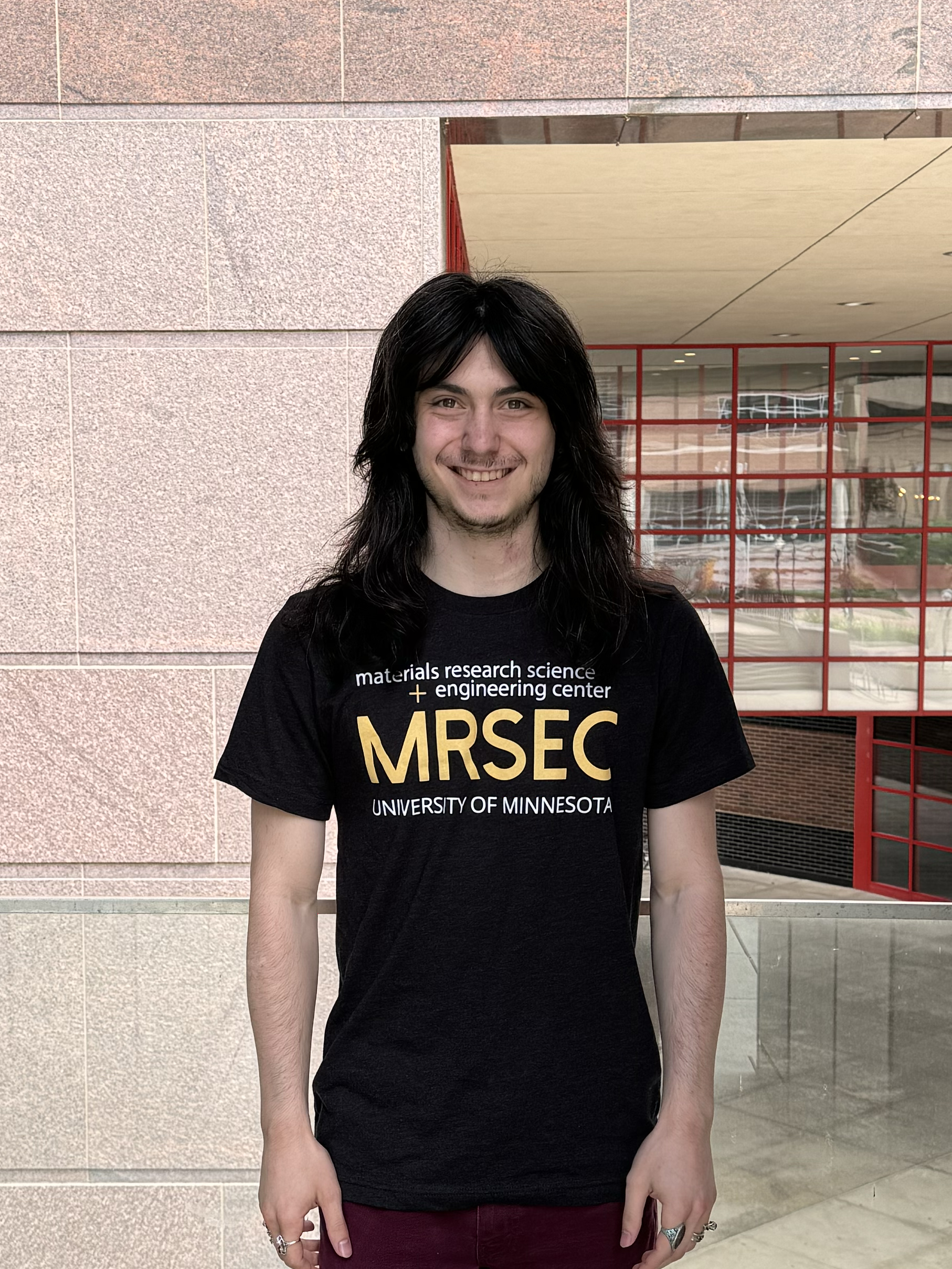
Home Institution: Augsburg College
REU Mentor: Xiang Cheng (UMN), Moumita Dasgupta (Augsburg))
Scaled-Up Experimental Modeling of Rotation Dynamics of Flagella at Constant Torque
Bacteria like E. coli are propelled by a bundle of helical flagella driven by rotary motors which operate under
a constant torque in the normal swimming condition. Although flagellated bacterial swimming has been extensively
studied, the collective dynamics of interacting flagella in a bundle dictated by complex hydrodynamic, elasto-
hydrodynamic and steric interactions is still not fully understood. To better understand this interplay, we are designing
an experimental macroscopic scaled-up model of flagellar bundles. Currently, we are testing a brushed DC motor to
implement constant torque using a feedback loop through a proportional-integral-derivative controller (PID). Trials
have been conducted to measure torque from a wide range of currents at different constant voltages by attaching
a uniform cylinder to the motor-shaft and immersing it in a cylindrical tank filled with a highly viscous fluid. This allows
us to calculate the torque of our motor using the principles of Couette flow, and this data will be used to better tune
our feedback loop. Once implemented, we will use particle image velocimetry to map the flow-field around our two
model flagella at varying distances from each other to gain important insights into the hydrodynamics of flagella in a
bundle driven by a constant torque.
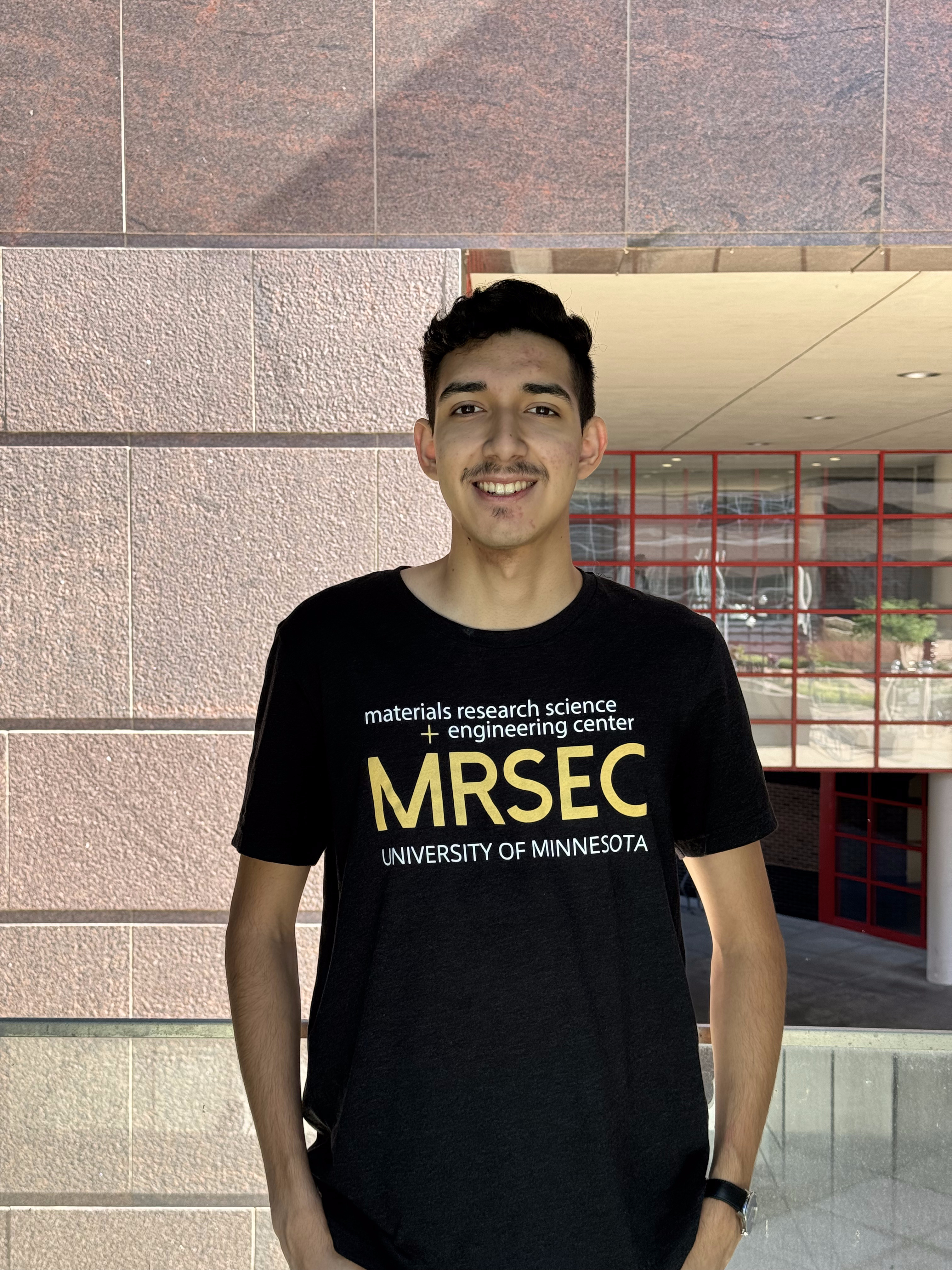
Home Institution: University of Texas Rio Grande Valley
REU Mentor: Chris Leighton
Enhancing Nanofiber based Triboelectric Nanogenerators via sputtered metal nanofilms
Tribolectric Nanogenerators(TENGs) could revolutionize wearable and portable electronics by converting
mechanical energy from everyday movement into electrical energy using the triboelectric effect. Nanofiber based
triboelectric nanogenerators are especially promising as their increased contact surface area allows for greater
charge transfer, in addition to their mechanical flexibility and biocompatability with human applications.To further
augment the charge transfer, vacuum magnetron sputtering will be used to produce nanofilms of various metals on
the surface of PLA nanofiber mats. The voltage generated by the modified nanogenerators will then be measured
and compared to each other to determine the optimal metal nanofilm. Afterwards, the optimal sample will be
characterized via X-Ray Diffraction(XRD) and X-Ray Reflectivity(XRR) to determine the crystal properties and verify
film thickness. Finally, a thickness dependency study will determine the optimal nanofilm thickness for maximizing
generated voltage.
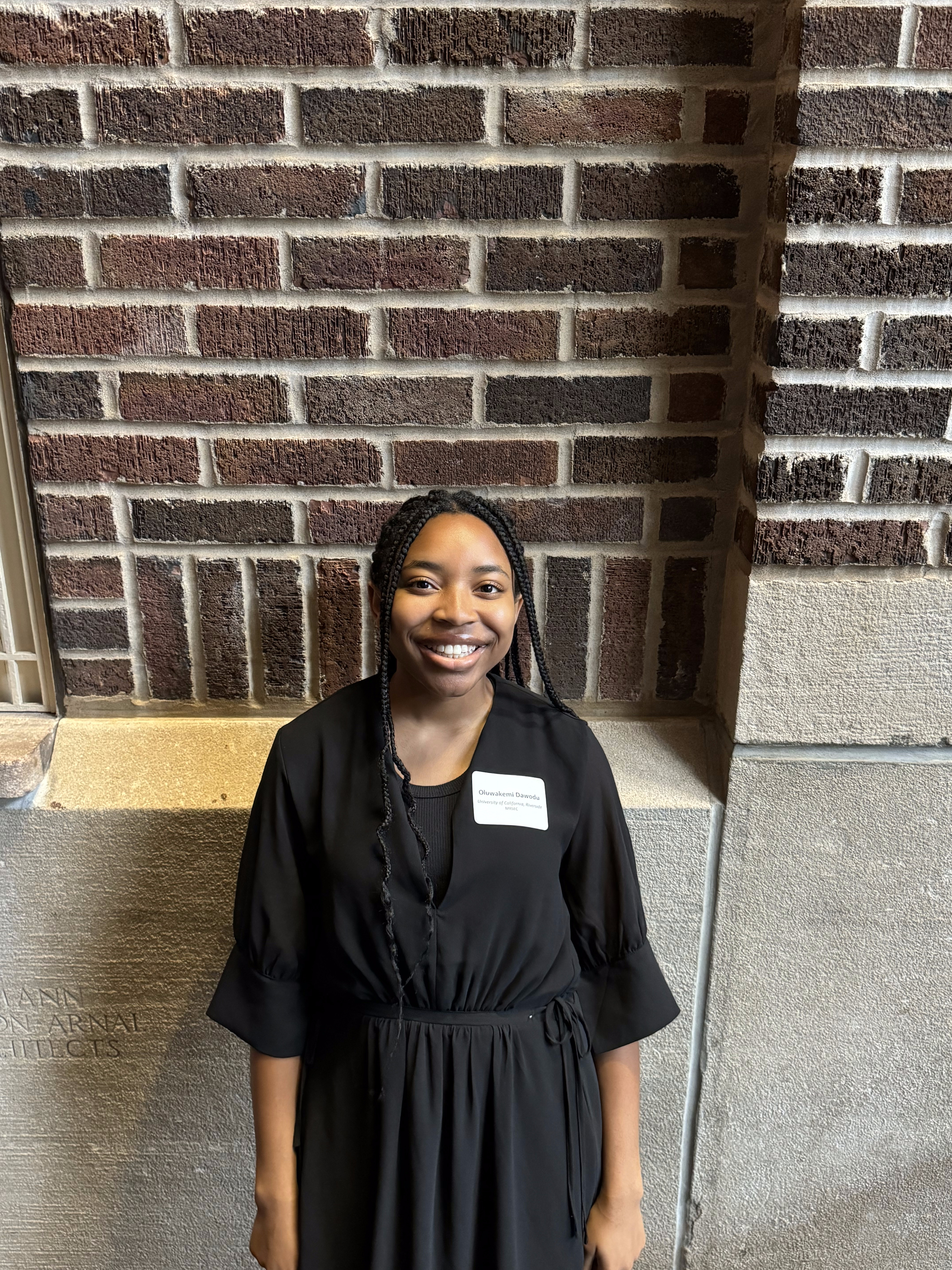
Home Institution: University of California, Riverside
REU Mentor: Ben Hackel
Discovery of Binders to the TROP2 Receptor for Targeted Cancer Drug Delivery.
Cancer is a complicated and nuanced disease that claims the lives of millions every year . Targeted drug
therapy has the potential to save numerous lives by preferentially deploying potent molecules on tumor cells while
avoiding healthy cells. Trophoblast cell surface antigen 2 (Trop2) is a cell surface glycoprotein that has one
intracellular domain, one extracellular, and a transmembrane, as well as a cytoplasmic tail used for signaling7. Trop2
is expressed in normal tissues, but is overexpressed in cancers like ovarian, prostate, pancreatic, and breast. The
reason Trop2 is overexpressed is not yet known, but it is a necessary driver in the proliferation of cancer cells and
controls the cell cycle through the calcium ion signaling pathway. Trop2 overexpression is associated with metastasis
and decreased patient survival. As such, Trop2 is a compelling target for immune engagers, radioligand therapy,
ligand-drug conjugates, and other drug targeted therapy. My goal is to identify a protein that can bind strongly (≤5
nM affinity) and selectively (≥100:1 stronger binder to Trop2 versus other proteins).Using a combination of three libraries
in yeast, sort for the best binding will be conducted using magnetic activated cells sorting and fluorescence activated
cell sorting.
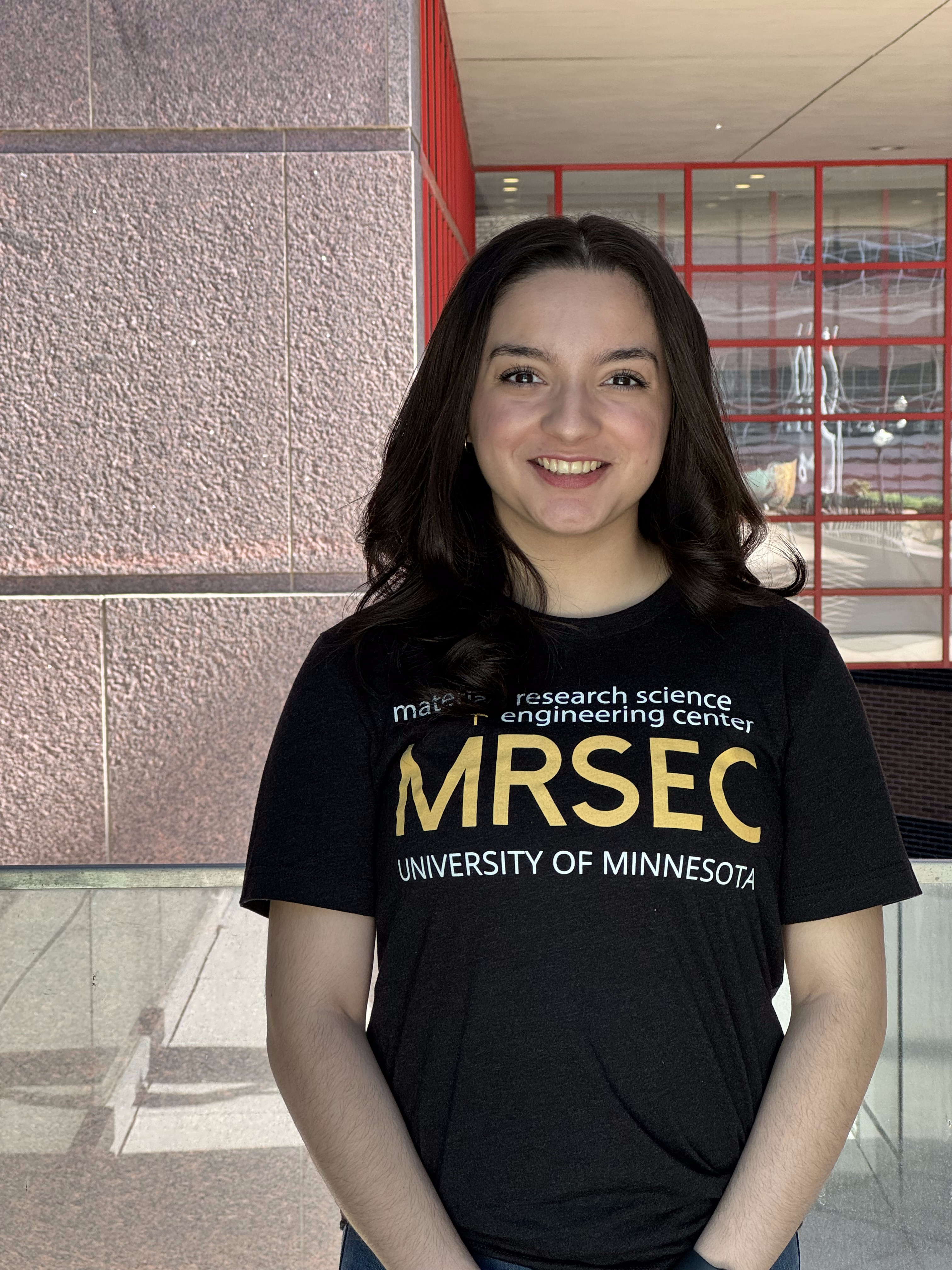
Home Institution: University of Texas Rio Grande Valley
REU Mentor: Lynn Walker
Incorporation of bio-oils in traditional elastomeric systems
In this study, we develop stretchable oil-swollen elastomers with triblock copolymers. Network structures were
achieved with ABA copolymer, polystyrene-block-poly (ethylene-co-propylene)-block-polystyrene, PS-PEP-PS (SEPS).
With a PS-PEP-PS triblock copolymer, glassy PS blocks can be linked through midblock PEP chains which leads to
network structures. When midblock selective oil is introduced, PEP chains that bridge PS blocks are swollen and this
can tune viscoelasticity of this network. Therefore, a triblock copolymer, such as SEPS, and a midblock-selective
solvent are to be used. This is to say, the purpose of this research study is to provide tunable elasticity to the SEPS
elastomer through the use of a midblock-selective solvent targeting the midblock PEP chains. By incorporating linear
rheology, we are better able to characterize and quantitatively assess the effect that increased concentrations of oil
as well as varied molecular weights of SEPS copolymers have on G’ and G”. In addition, an AB diblock copolymer,
polystyrene-block-poly (ethylene-co-propylene), PS-PEP (SEP), is to be used as a source of comparative analysis as
diblock copolymers are not able to form bridges due to the lack of an extra PS block. Further analysis of the
concentrations of network structures and their behavior are derived from such characterization.
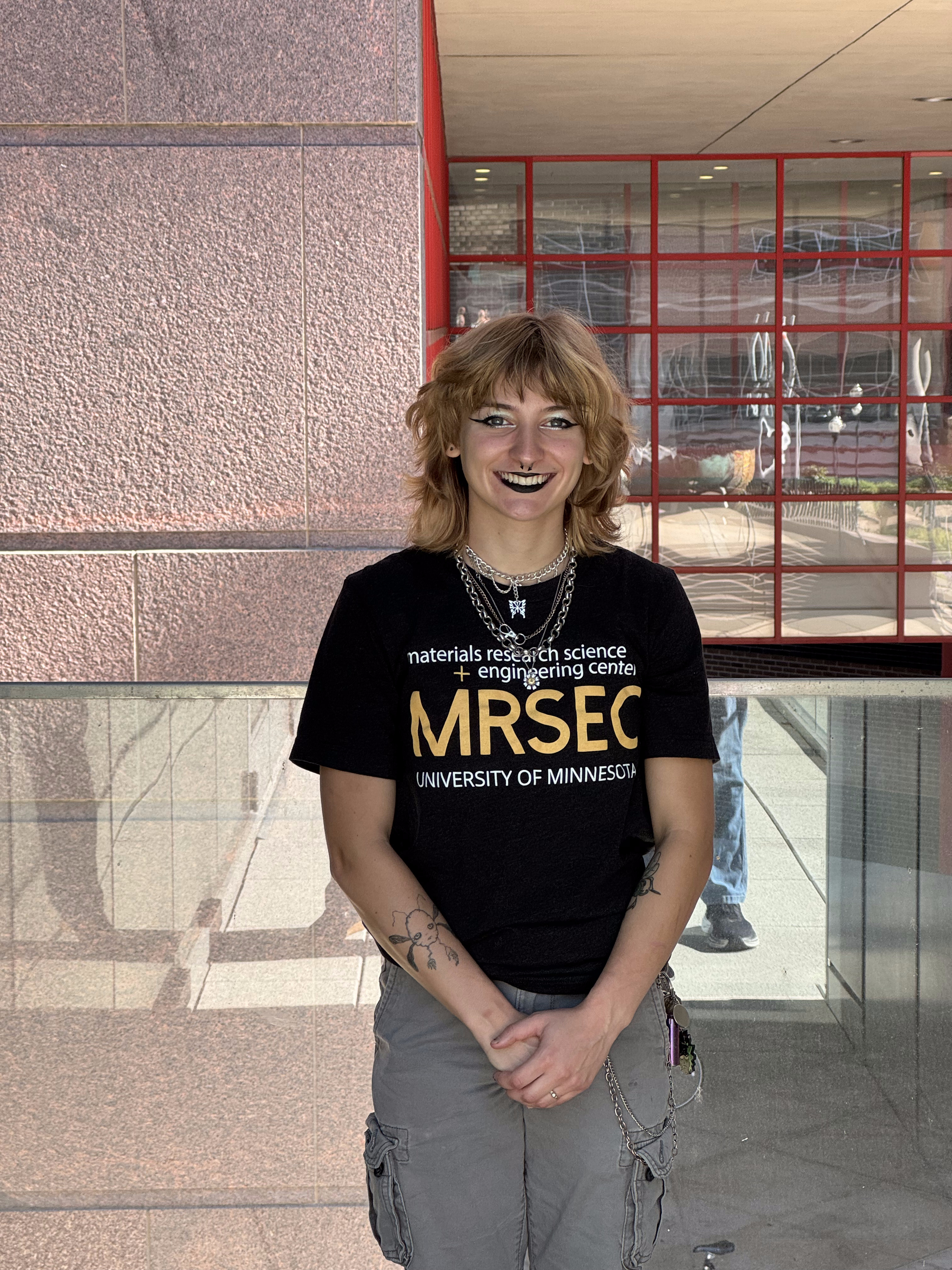
Home Institution:Baylor University
REU Mentor: Boya Xiong
Antimicrobial protein modified microfiltration membranes for pathogen removal in drinking water treatment.
Moringa oleifera (MO) possesses cationic proteins within its seeds that have known antimicrobial properties.
By coating a polydopamine (PDA)-modified commercial polyvinylidene fluoride (PVDF) microfiltration (MF)
membrane with MO proteins, we created a membrane that can potentially disinfect pathogens in water. To do so,
MO seeds were ground and extracted for water soluble cationic protein. The PVDF MF membrane was first modified
with PDA, followed by the aforementioned protein serum (PVDF_PDA_protein), both via a dip coating method. A non
PDA-modified membrane was made using vacuum filtration. To assess the success of protein coating, the surface
chemistry of the modified membrane was analyzed using Attenuated Total Reflectance FTIR Spectroscopy; this
analysis confirmed successful coating of both PDF and protein onto the membrane. The performance of the
membranes was assessed for water permeability using dead-end filtration, which was shown to increase slightly with
modification. We plan to access the antibacterial activity using contact kill and filtration experiments with E. coli, B.
subtilis and MS2 bacteriophage. Additionally, resistance to biofouling will be assessed using P. aeruginosa, where we
project inhibition or delay in biofilm formation. This work potentially could offer a novel, effective, simple, and
sustainable water treatment technology for water-borne pathogen removal.
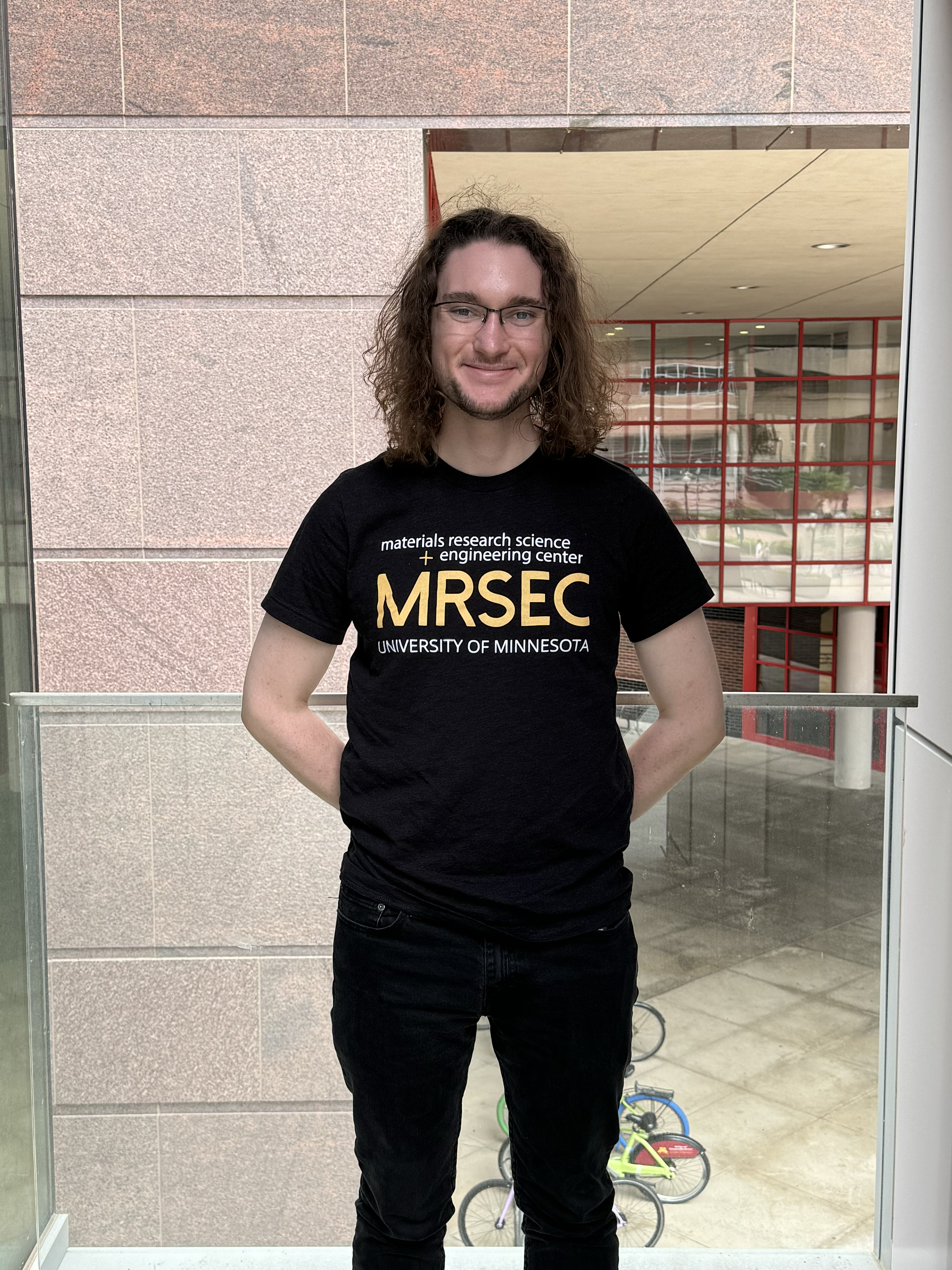
Home Institution:Augsburg University
REU Mentor: Xiang Cheng, Moumita Dasgupta
Implementation of Constant Torque Control in a Macro-Scale Flagellar Model
Many microorganisms use tiny molecular motors with propeller-like filaments called flagella to move through
their fluid environments. Our lab's broad goal is to develop a macro-scale model of multiple flagellar motors to
examine the fluid dynamics of the flagella bundling and the transitions to and from the non-bundling phase. These
micromotors operate in high-viscosity conditions using constant torque, so my task was to develop a setup capable
of controlling a motor's torque when spinning its rotor in a viscous fluid. We used aluminum cylinders as our test rotors
because we can calculate their torque directly, and they simplify the system so there are fewer unknowns to factor
in. We used a motor microcontroller and its built-in PID current control to adjust the motor's torque and keep it stable
against fluctuations.
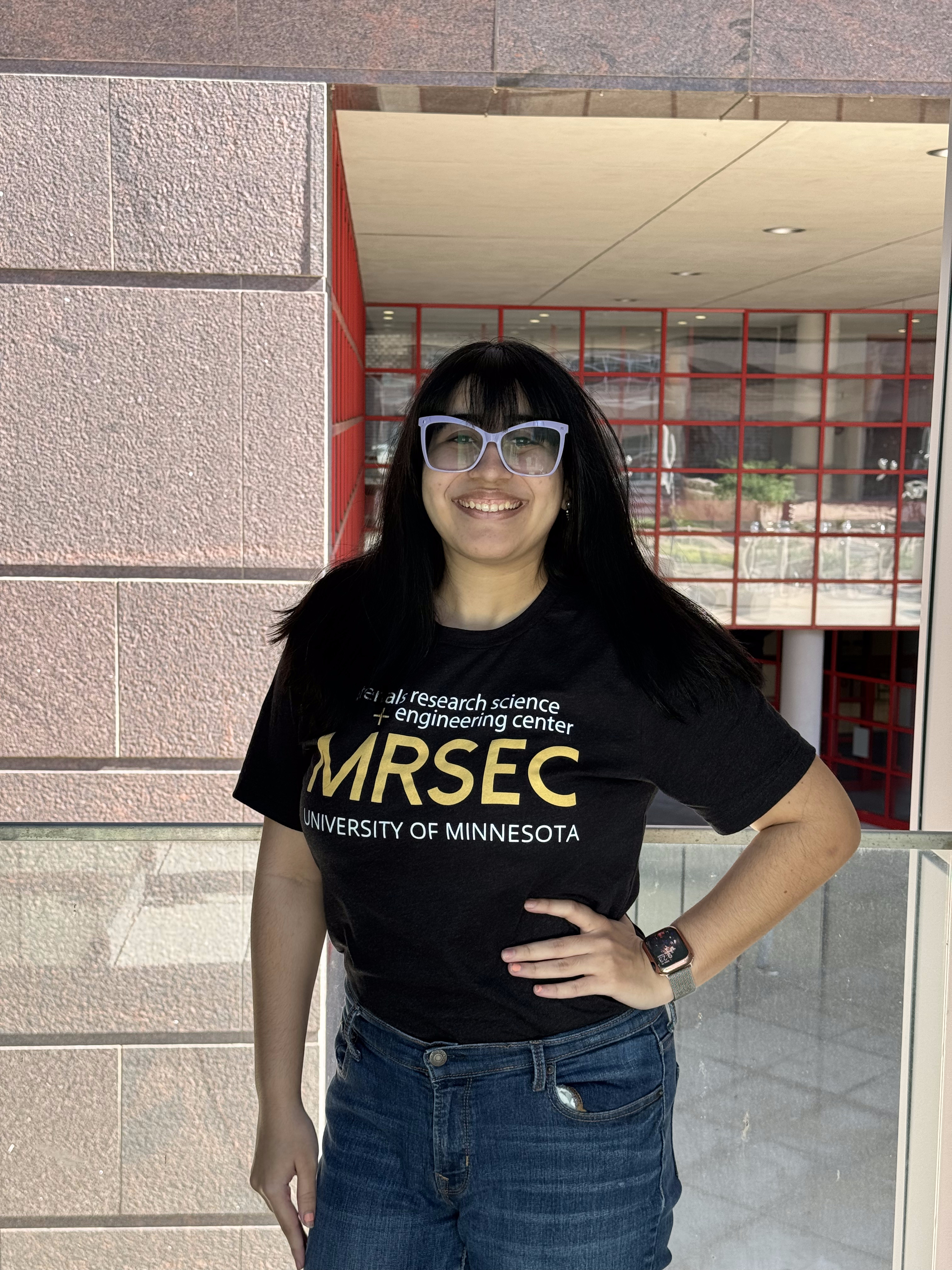
Home Institution: University of Puerto Rico, Cayey Campus
REU Mentor: Natalie Boehnke
Poloxamer Gels in Biocompatible Ionic Liquids to Treat Middle Ear Infections
Nanomedicine offers a promising alternative to traditional chemotherapy by reducing off-target toxicity
and enabling targeted drug delivery. In a recent high-throughput nanoparticle study, nano-bio interactions that
predict successful nanoparticle (NP) delivery were probed, and it was discovered that certain biologic features can
be predictive of delivery outcomes. SLC46A3 was identified as a negative regulator of lipid-based NP uptake, a finding
not applicable to polymeric nanoparticles like those composed of poly(lactic-co-glycolic acid) (PLGA). As PLGA NPs
are an attractive choice due to their biodegradability, biocompatibility, and controlled drug release capabilities, we
are interested in gaining a deeper understanding of the relationship between SLC46A3 levels in cells and NP delivery,
particularly in the context for drug-loaded NPs. This study focused on developing PLGA NPs loaded with doxorubicin
(DOX), a chemotherapeutic known for its efficacy but also for severe side effects like cardiotoxicity. Via an amide
linkage, DOX was conjugated to PLGA because we hypothesize a covalent conjugation will minimize drug loss and
enhance stability compared to non-covalent methods. The conjugate was characterized by H-NMR and HPLC.
Nanoparticles were formed using nanoprecipitation, with size and polydispersity index characterized by dynamic light
scattering and zeta potential measured using electrophoretic light scattering.
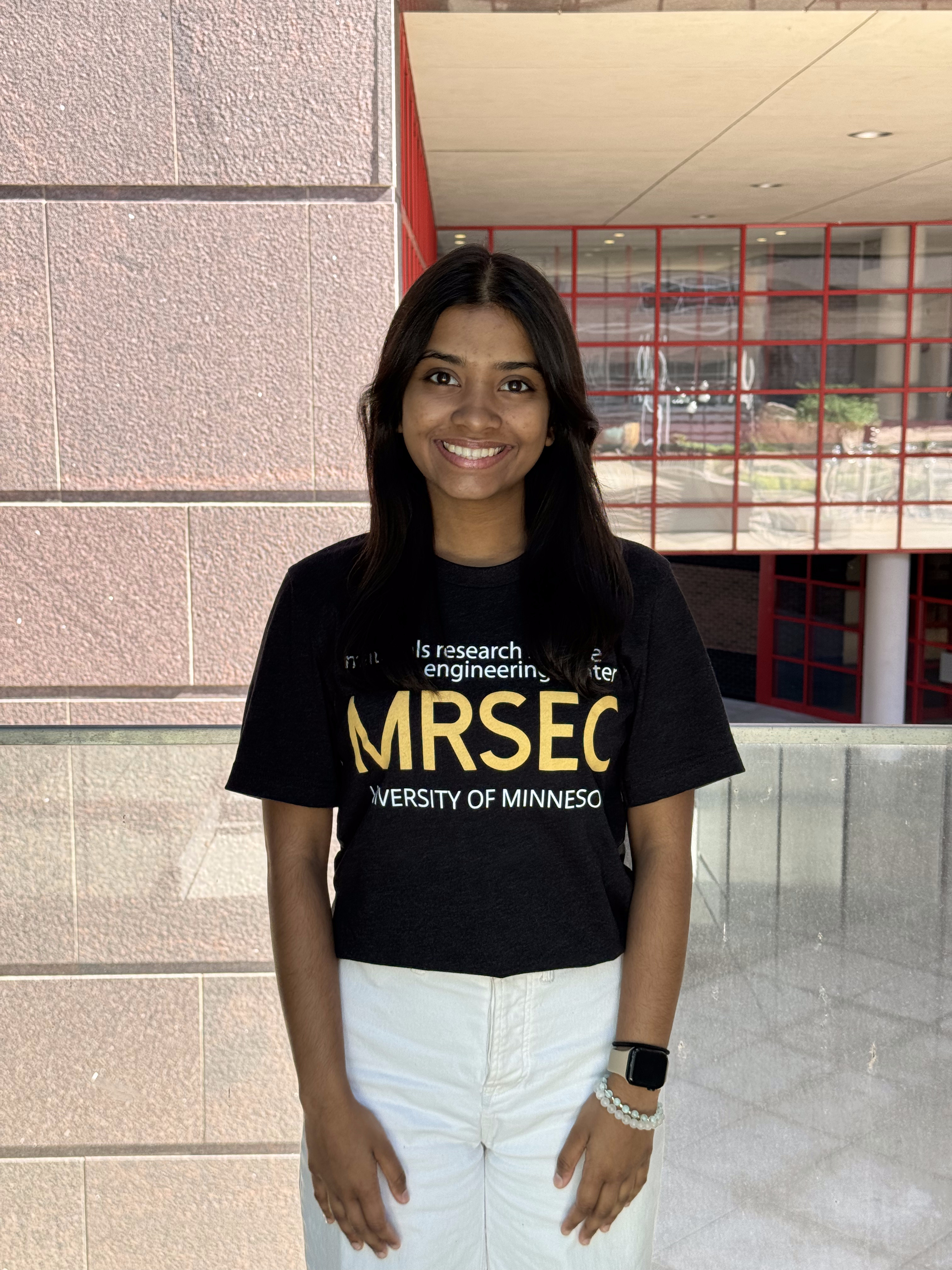
Home Institution: Iowa State University
REU Mentor: Mahesh Mahanthappa
Investigation of Lyotropic Mesophases formed by Catanionic Surfactants
Ionic surfactant molecules form lyotropic liquid crystals (LLCs) due to water-driven self-assembly. This project
aims to develop network phase LLCs with embedded chemical functionality using catanionic surfactant mixtures to
develop ion-selective membranes. Catanionic surfactants are mixtures of oppositely charged amphiphiles. The
catanionic system of a diammonium Gemini cation paired with a carboxylate anion was formed and investigated to
determine how surfactant architecture influences morphology. A diammonium Gemini surfactant (Br-10,6) was
successfully synthesized via a Menshutkin reaction between N, N, N’, N’-tetramethyl-hexane diamines, and 1-
bromoundecane. This was followed by an ion exchange to make the hydroxide form of the diammonium Gemini
surfactant (HO-10,6). A salt-free catanionic surfactant was formed by the acid-base reaction between HO-10,6 and
lauric acid. The purity and composition of the synthesized surfactants were characterized through 1H-NMR and
elemental analysis. Small-angle X-ray Scattering (SAXS) patterns and Polarized Light Microscopy (PLM) experiments
show a hexagonally packed cylinder phase for the LLCs formed by the Br-10,6 surfactant. Birefringence was observed
for LLCs formed by the catanionic system by PLM experiments, indicating the presence of non-cubic, ordered phases.
Future work includes more SAXS and PLM experiments to identify favorable conditions to form network phase LLCs.
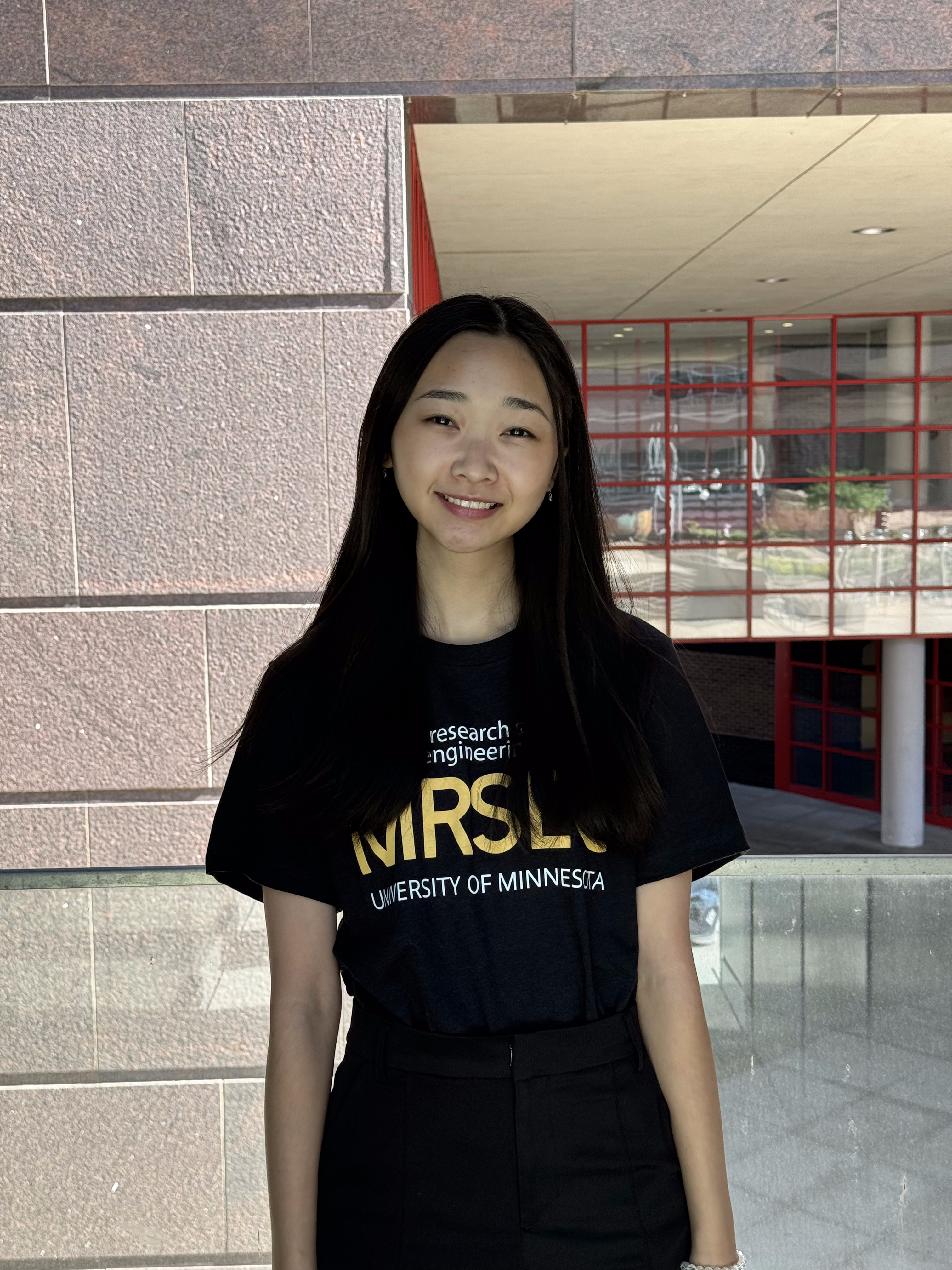
Home Institution: Colorado School of Mines
REU Mentor: Theresa Reineke
Optimizing the Bioactive Modification of Alginate Films for MSC Proliferation
Mesenchymal stem cell (MSC) treatments are promising for cellular therapy and tissue regeneration for their
abilities to self-renew and differentiate. Treatments require billions of MSCs, but current production methods using
proteolytic enzyme detachment have issues with cell detachment and premature differentiation. MSC health and
quantity can be improved by instead implementing dissolvable bioactive modified-alginate films. Various moieties
were coupled to the alginate carboxylate anion for biofunctionalization using 4-(4,6-Dimethoxy-1,3,5-triazin-2-yl)-4-
methylmorpholinium chloride (DMTMM). This coupling chemistry was optimized using N,N-diethylethylenediamine
(DEDA) as the model amine, elucidating the effects of different reaction conditions including pH, buffers, and the
limiting reagent. Alginate films modified with DEDA, arginine methyl ester (AME), or ECM-mimicking peptides were
tested for MSC attachment, concluding peptides as a bioactive moiety. Other addition chemistries are being
investigated to study how the chemical linkage—bonding between the alginate and bioactive moiety—affects
cellular behavior. These multi-step schemes make use of DMTMM or tetrabutylammonium bromide (TBAB) to attach
a functional group, useful in an orthogonal chemistry. Each is optimized by screening temperature, pH, and reactant
equivalences. The tuned addition chemistry pathways elucidated from this work can be widely applied to different
moieties, serving as a foundation for future biofunctional modifications.
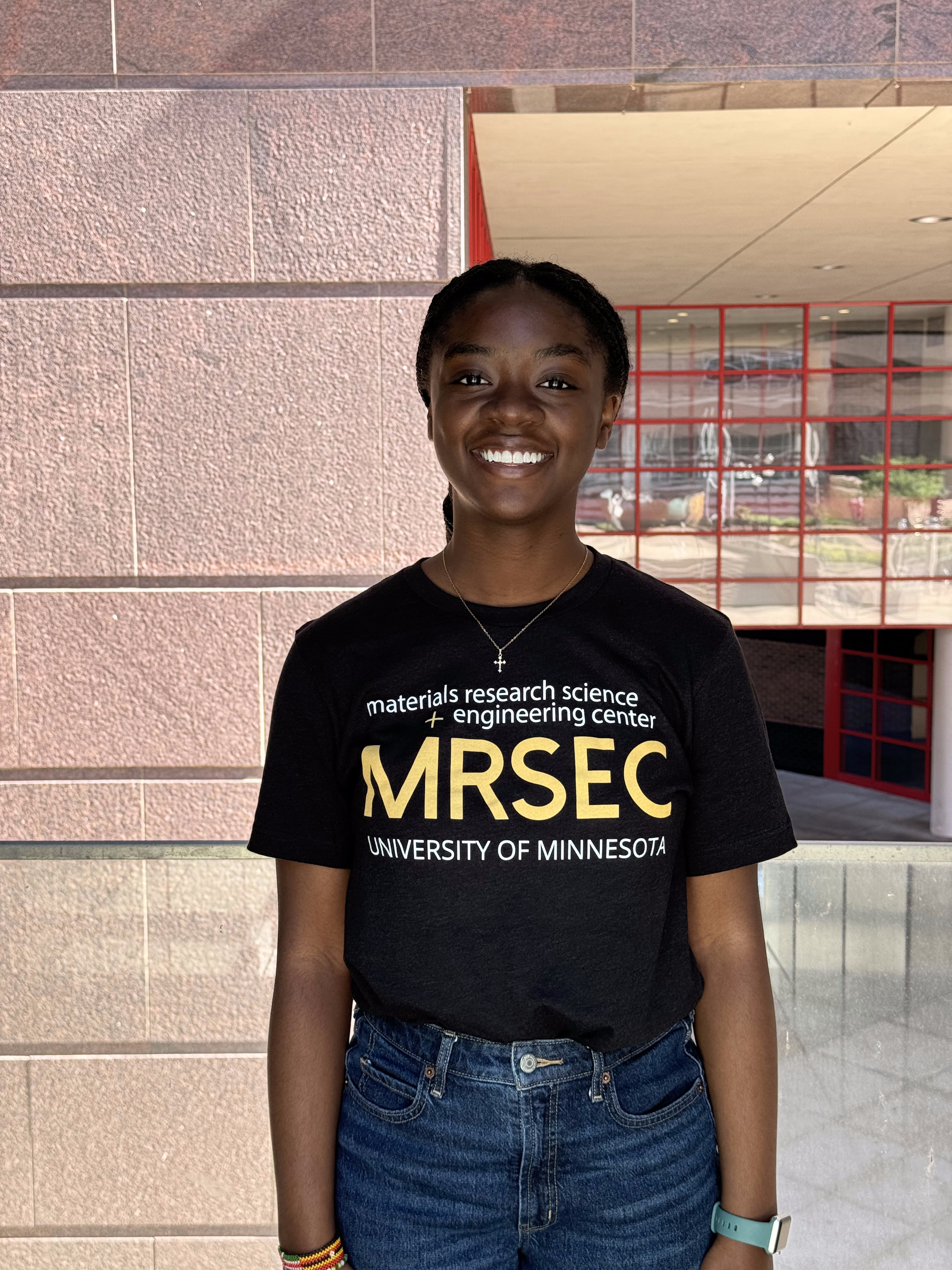
Home Institution: Iowa State University
REU Mentor: Ben Hackel
Engineering Immune Engager Stability
Tri-specific killer engagers (TriKEs) are immunotherapeutics designed to treat cancer. TriKEs contain three
parts: a nanobody that stimulates the CD16 receptor on NK (natural killer) cells, an IL-15 cytokine that promotes an
increased NK cell response, and an scFv (single chain Fragment variable) that binds to a tumor-associated antigen,
thus inducing NK cell activation and tumor cell killing. ScFvs are challenging to utilize in therapeutics due to their
instability. In comparison, miniproteins are binding scaffolds about ≤100 amino acids. They are appealing for use in
therapeutics due to their modularity within multifunctional constructs, low manufacturing cost, and high resistance to
denaturation and proteolysis. This project will test the hypothesis that TriKEs containing hyperstable miniproteins will
demonstrate increased stability and production yield compared to TriKEs containing scFvs. I will produce two TriKEs
with a miniprotein or scFv tumor engager. I will quantify recombinant yield via gel electrophoresis and validate TriKE
size using matrix-assisted laser desorption/ionization mass spectrometry. I will measure each TriKE’s midpoint of thermal
denaturation using circular dichroism. Given our hypothesis, we expect the miniprotein TriKE to demonstrate superior
expression yield and thermal stability. Both TriKEs will target the B7-H3 cancer marker, advancing treatments for B7-H3
positive cancers.
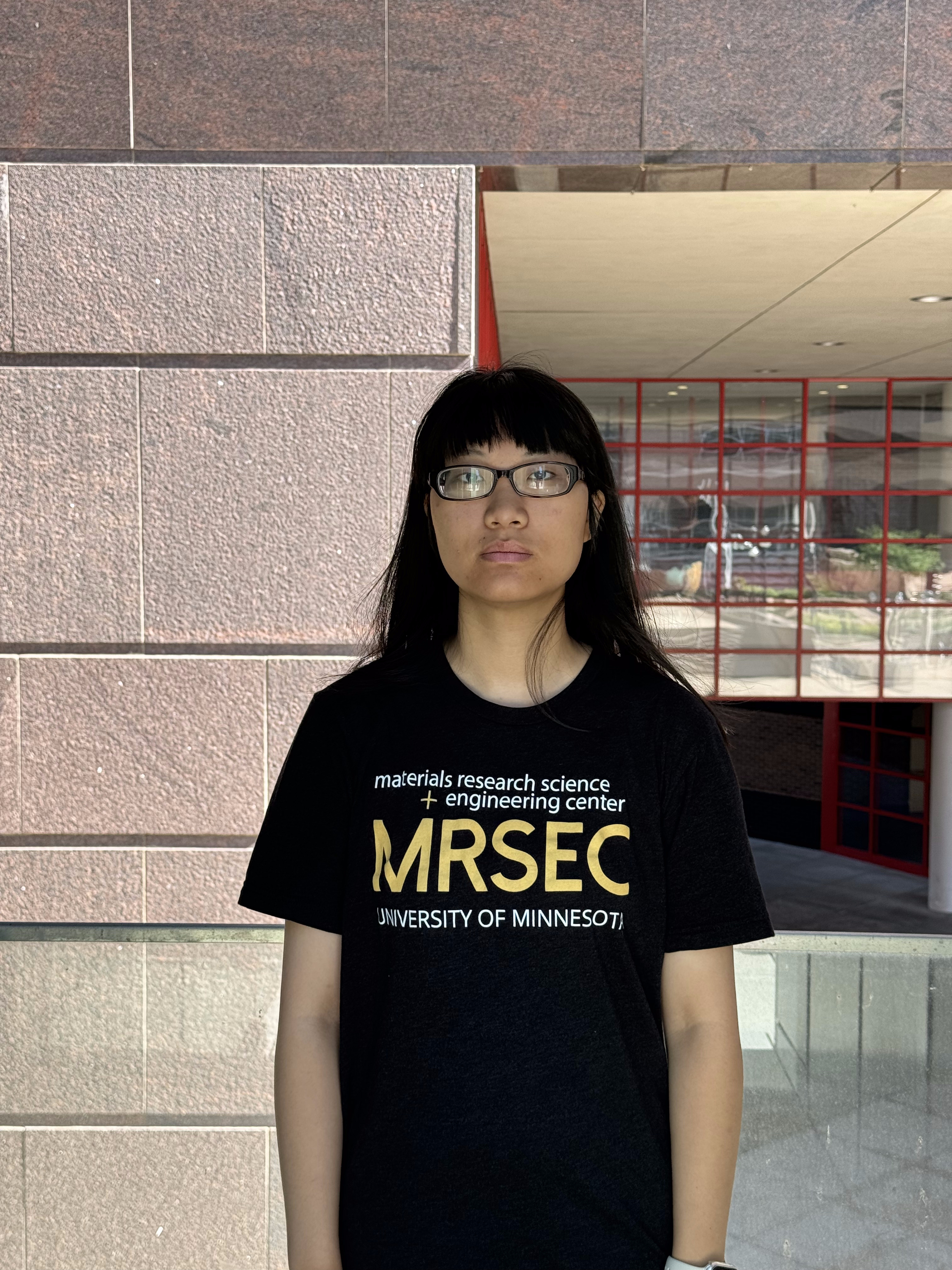
Home Institution: University of Michigan
REU Mentor: Vivian Ferry
Computational Modeling of Optical Properties of Disordered Polymer Microstructures for Passive Daytime Radiative
Cooling
Passive daytime radiative cooling (PDRC) results in net zero energy consumption and zero environmental
pollution by leveraging the heat differential between Earth and outer space. PDRC materials must absorb little solar
radiation and emit long wavelength infrared radiation through the atmospheric transmission window. Polymers have
chemical bonds that emit in the atmospheric transmission window and can be produced at scale for low cost.
However, polymers do not inherently reject solar radiation. One solution is to give polymers microstructures with
domain sizes similar to or larger than the wavelengths of solar radiation to tailor the optical responses. Using
computational modeling, we studied the solar reflection spectra of disordered cocontinuous microstructures derived
from polymer blends, which self-assemble through spinodal decomposition. A Cahn-Hilliard model describing the
spinodal decomposition process was used to generate microstructures of varying domain sizes. The finite-difference
time-domain (FDTD) method, which spatially solves Maxwell’s equations, was used to simulate how the domain size
influenced reflection spectra. As a result of this work, we have created a simulation pipeline for understanding how
domain size influences light management in cocontinuous porous polymers with the goal of providing guidance for
PDRC material development.
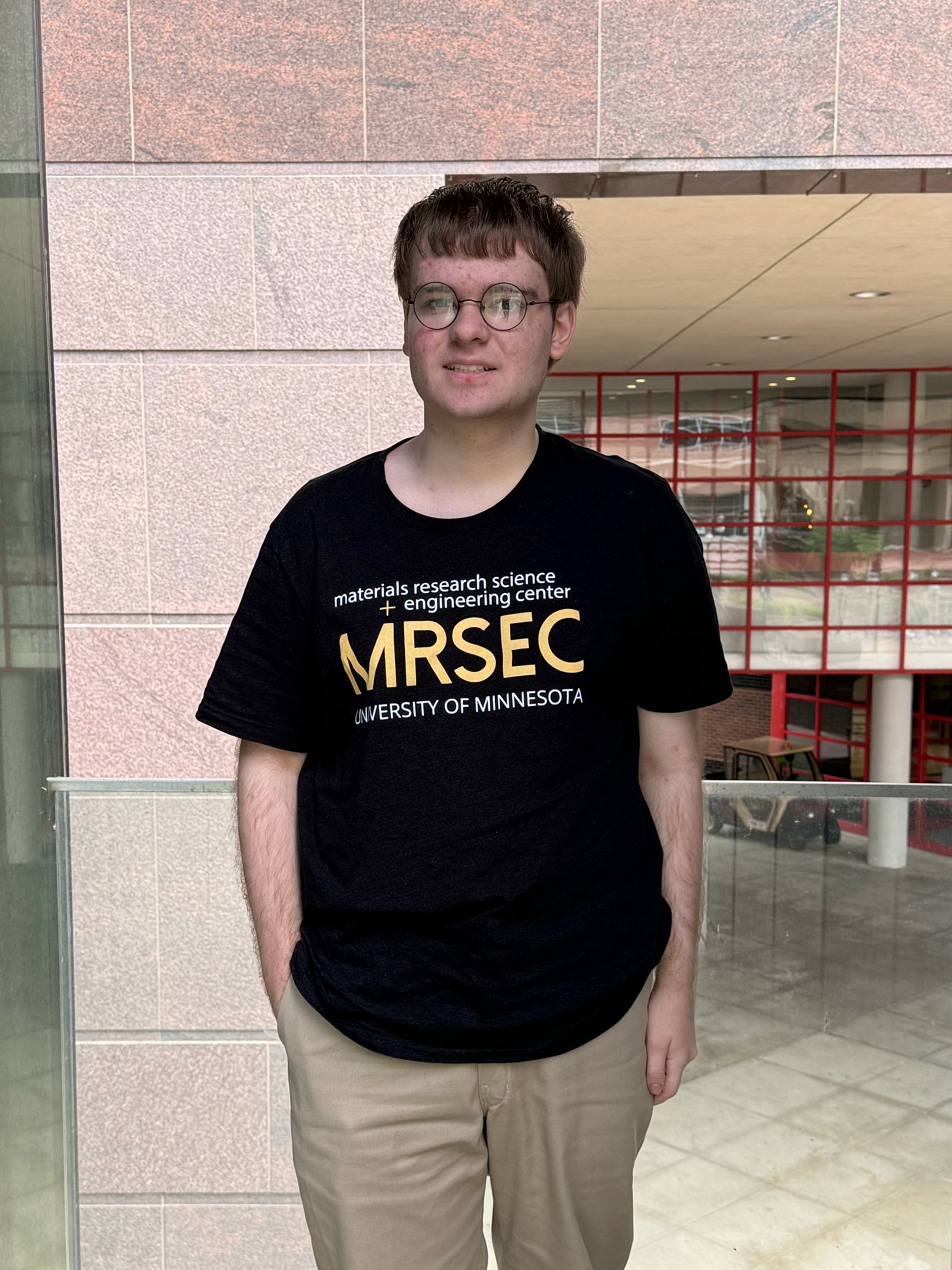
Home Institution: University of Maryland Baltimore County
REU Mentor: Mahesh Mahanthappa
Magnetic Response of Superconducting Ion Gated Materials
Titanium Diselenide (TiSe2), and Molybdenum Disulfide (MoS2), are part of the class of two-dimensional
chalcogenide materials with interesting properties such as superconductivity. In particular, ion gating can be
leveraged to tune electronic order in these materials. When an ionic liquid is applied to a material, the charges
migrate to the surface and introduce extra charges (or holes) in the material, thus, changing its properties. Here, we
use this technique to investigate the magnetic response. When a changing magnetic field is applied, Eddie currents
are created in the superconductor which generate a magnetic response that opposes the change, also known as
the Meissner Effect. When an oscillating field is applied, the sample will respond in harmonics, With the use of a multi-
coil setup, we will measure the magnetic response up to third order. This magnetic response probe will allow us to
perform gating experiments to investigate the effect of ion gating on TiSe2 and MoS2, which are expected to become
superconducting for sufficiently high gate voltages. Measuring the third harmonic responses of these materials will
broaden our understanding of the emergence of the superconducting state above the superconducting transition
temperature.
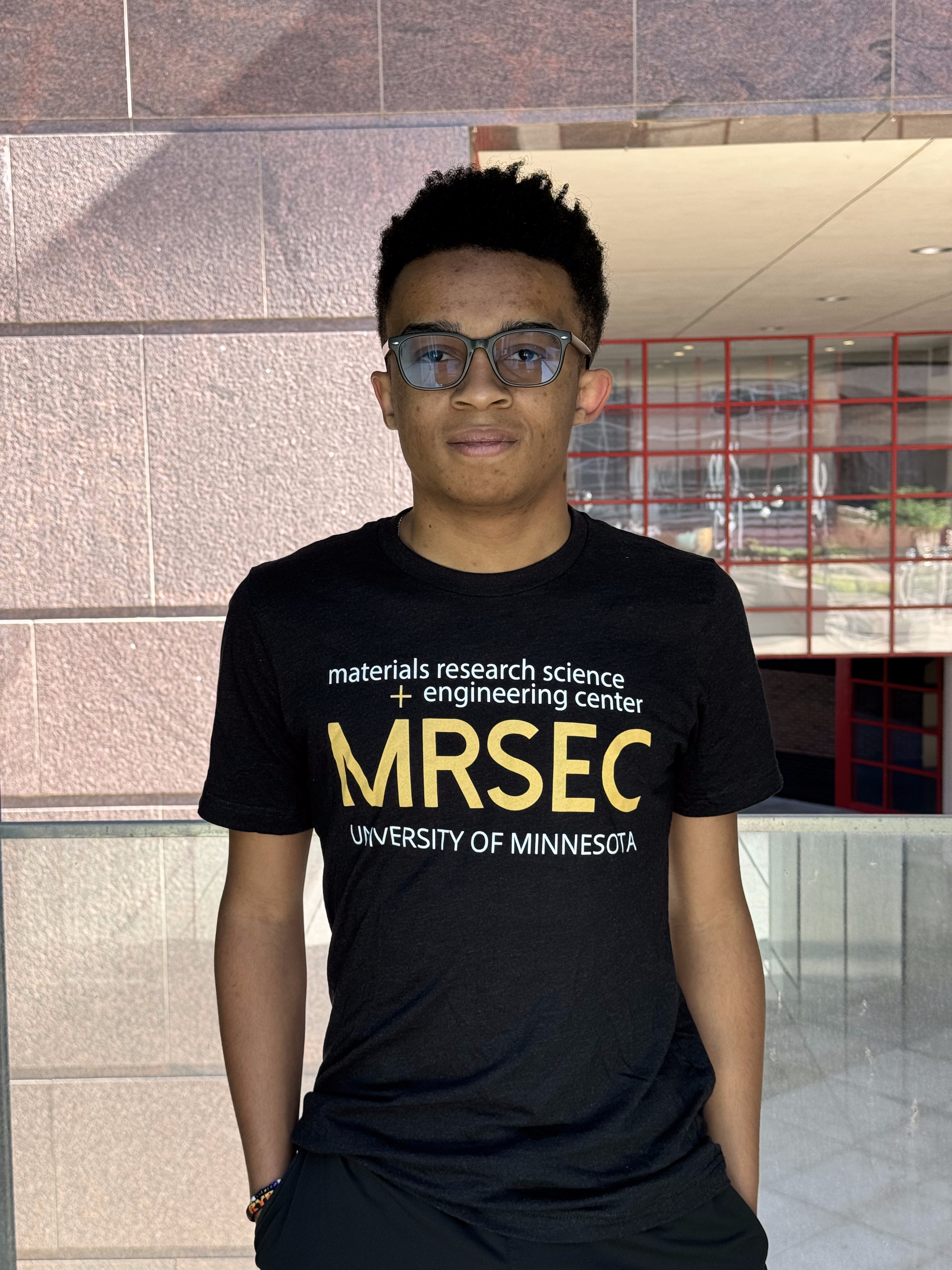
Home Institution: University of Maryland, Baltimore County
REU Mentor: Ilja Siepmann
Data Analysis of Amphiphilic Morphologies
Amphiphiles; oligomers that are instantiated by a hydrophilic “head” group followed by an asymmetric and
hydrophobic “tail” group, have been shown to have varying morphologies with respect to their “long-tail” to “short-
tail” atom count ratio, which we have declared to be the magic tail ratio (MTL) of the amphiphilic oligomer.
Depending on the amphiphile’s MTL; an amphiphile’s morphology can present itself in the form of lamellae (LAM),
perforated lamellae (PL), hexagonal cylinders (CYL), and double gyroids (DG), with DG resulting in being the most
stable category of amphiphile morphology. Our goal is to be able to achieve an understanding of these morphology
patterns and their stabilities with computational modeling and analysis using OVITO, and use of non-linear
optimization algorithms from C++ Libraries such as NLopt and Eigen to efficiently find patterns within mass amounts of
data. We currently expect but remain uncertain that an a between an amphiphile’s MTL is responsible for their varying
morphologies
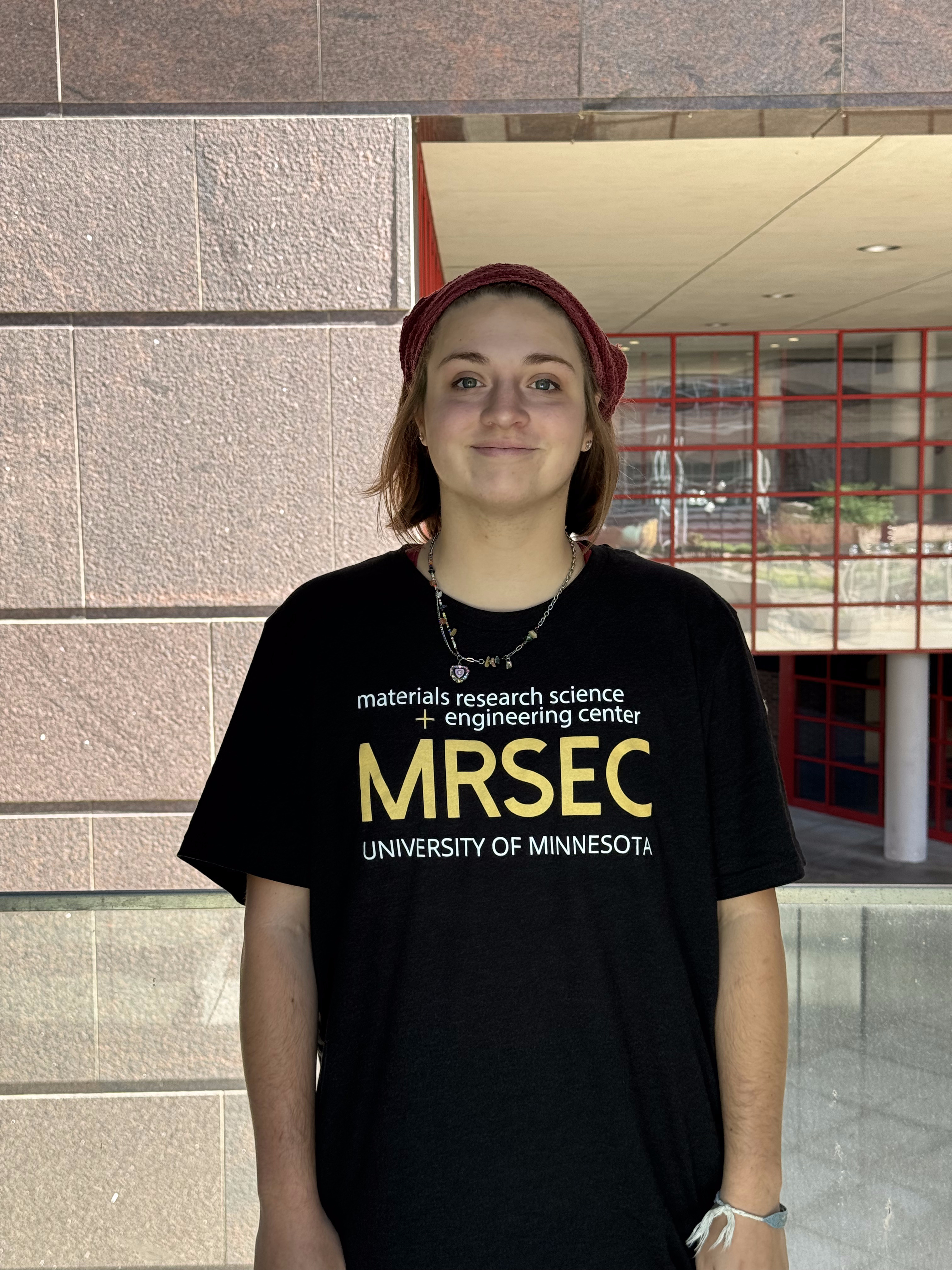
Home Institution: Harvey Mudd College
REU Mentor: Jessica Lamb
Expanding the scope of TCT mediated cationic-anionic sequential polymerization for block copolymers
Block copolymers (BCPs) are polymers formed from multiple monomers in discrete blocks. These materials
may have unique properties and functions. Generally, when synthesizing BCPs, the same polymerization method
(radical, anionic, cationic) must be used to add each monomer—limiting the class of monomers one can use. The
Lamb research group uses thiocarbonyl thio (TCT) compounds to mediate both cationic and anionic polymerizations
triggered by light and heat, respectively. This enables the synthesis of BCP’s composed of vinyl ether and thiirane
blocks. However, the scope of the BCPs possible is currently limited to one vinyl ether monomer—ethyl vinyl ether. This
is because it is the only known poly(vinyl ether) soluble in the anionic polymerization solvent. This summer, we
attempted to expand the scope of BCPs possible by investigating alternative solvents and solvent mixtures for the
anionic polymerization. Vinyl ether polymers were synthesized and their solubility in a range of solvents was
characterized. Next, anionic polymerization was performed in these solvent mixtures and the conversion and dispersity
of the resulting polymers was characterized by NMR and SEC. Finally, solvent mixtures that showed promise for the
thiirane homopolymerization were used to chain extend vinyl ether polymers to create novel BCPs.
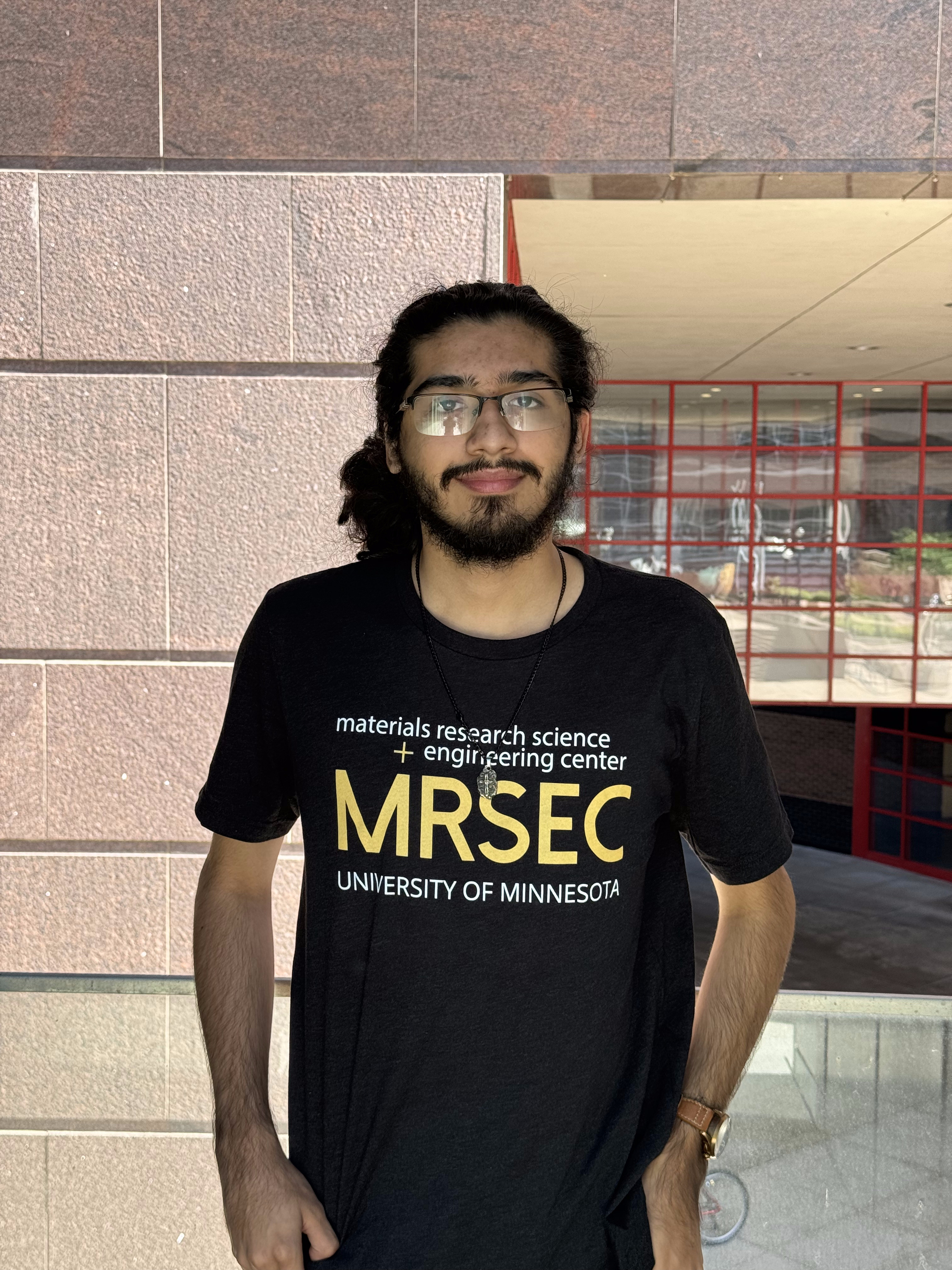
Home Institution: The University of Texas Rio Grande Valley
REU Mentor: Timothy Lodge
Effect of corona chain entanglement on structure and dynamics of homopolymer/diblock copolymer binary blends
Block copolymers can self-assemble into nanoscale spheres called micelles. In concentrated solutions,
micelles can order into a body-centered cubic (BCC) lattice. Understanding the relationship between structural and
dynamic properties of ordered micelle is crucial for designing polymers for industrial applications. This study uses a
polystyrene-poly(ethylene-alt-propylene) (PS-PEP) diblock polymer in squalane, a solvent selective for the PEP block,
to form micelles with a PS core and a PEP corona. We will investigate the effects of corona chain entanglement on
the rheological, or flow, behavior of BCC-packed block copolymer micelles by blending varying amounts of PEP
homopolymer with PS-PEP diblock. The primary objective is to determine how altering corona entanglements
influence micelle properties and dynamics, more specifically whether chain entanglement is the sole determinant of
the dominant rheological timescale. To focus on chain entanglement, we will fix the concentration of PS-PEP and
modulate the ratio of PEP homopolymer and squalane. We will use small-angle X-ray scattering to analyze the
microstructure, such as micelle core size and domain spacing. Afterwards, rheology will be used to determine the
flow behavior at temperatures –40 °C to 160 °C. These methods aim to understand the relationship between structure
and dynamics of block copolymer-based micelle solutions.
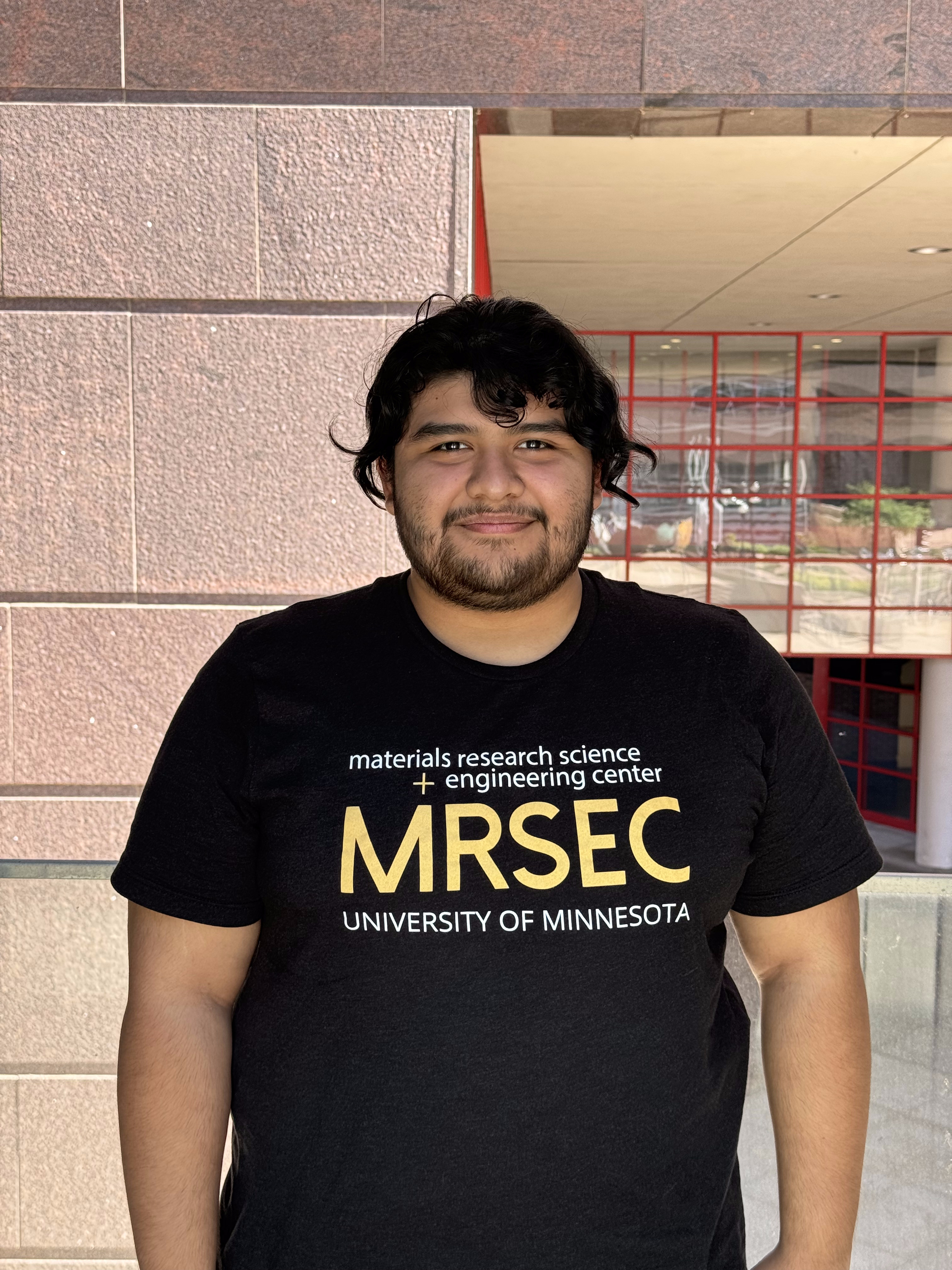
Home Institution: The University of Texas Rio Grande Valley
REU Mentor: Michelle Calabrese
Predicting Fiber Spinnability through Dripping-onto-Substrate Extensional Rheology
Nature's nanofibers (1 nm-1 µm), exemplified by silkworms, are lightweight, have controllable pore structures,
and possess high surface area-to-volume ratios, making them ideal for applications like filtration, sensors, textiles, tissue
engineering, and energy storage. However, these applications often demand properties beyond those of natural
fibers, spurring interest in polymer-based nanofibers with tunable performance. While electrospinning is a common
production method, it requires high voltage, has low production rates, and is limited in compatible formulations.
Centrifugal spinning (ForceSpinning™) offers a higher production volume, operational ease, and nanofibers with
controlled morphological features and mechanical properties comparable to electrospun fibers. This study aims to
investigate the elongational flow behavior of polymer solutions/emulsions using dripping-onto-substrate (DoS)
extensional rheology. Initial experiments with aqueous poly(ethylene oxide) (PEO) solutions will lead to a detailed
study on PEO/polycaprolactone emulsions in chloroform with a set range of internal and external phases. Analyzing
the breakup behavior of these solutions under extension will reveal polymer properties essential for consistent
spinnability. This research aims to elucidate the structure-process-property relationships during ForceSpinning™
,
facilitating the rapid screening of samples for this technique potentially revolutionizing high-throughput nanofiber
production for advanced applications.
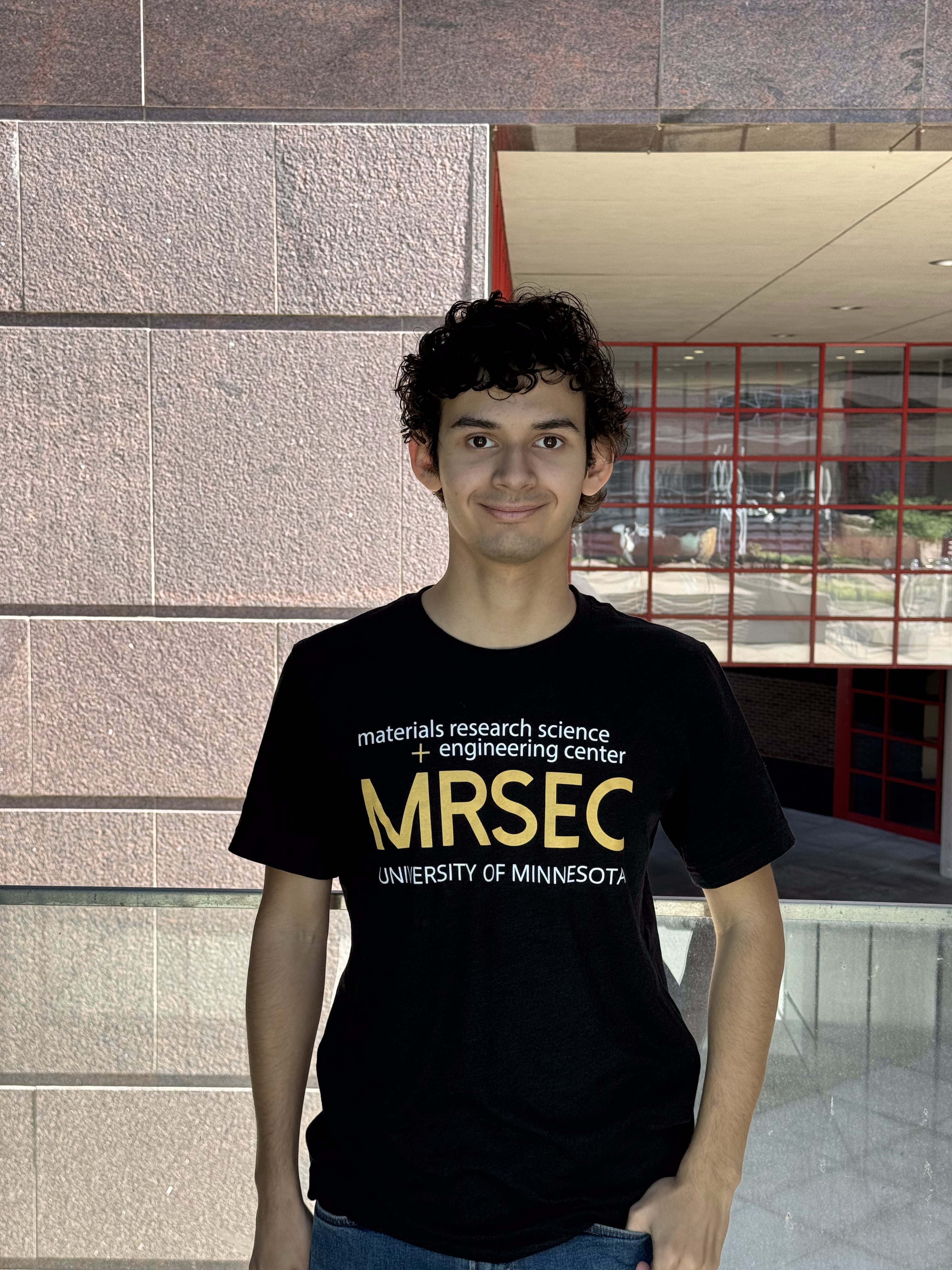
Home Institution: University of Texas Rio Grande Valley
REU Mentor: Chris Ellison
Producing Water Repellent Fibers using Polyester-PDMS Copolymers and Melt-Blowing
We are making hydrophobic fibers with a robust surface coating using a simple and scalable processing
method. Using a microcompounder, we can blend Polyester with a small concentration of hydroxyl-terminated PDMS
(Polydimethylsiloxane) to form a Polyester-PDMS copolymer. Then, we can produce fibers from the blends by melt-
blowing, an industrial method used to produce large quantities of fibers. We hypothesize the low surface energy of
PDMS will make the copolymer located at the surface of the blend. We study different mechanisms of surface
blooming using films, fibers, and annealing procedures. We evaluate if this process occurs during melt-blowing by
testing if the surface of the fibers is more hydrophobic. We can measure hydrophobicity by measuring the contact
angle of a water drop on the surface of fiber mats. We evaluate different ratios of the polymers to determine how
much PDMS is necessary to make the fibers hydrophobic.
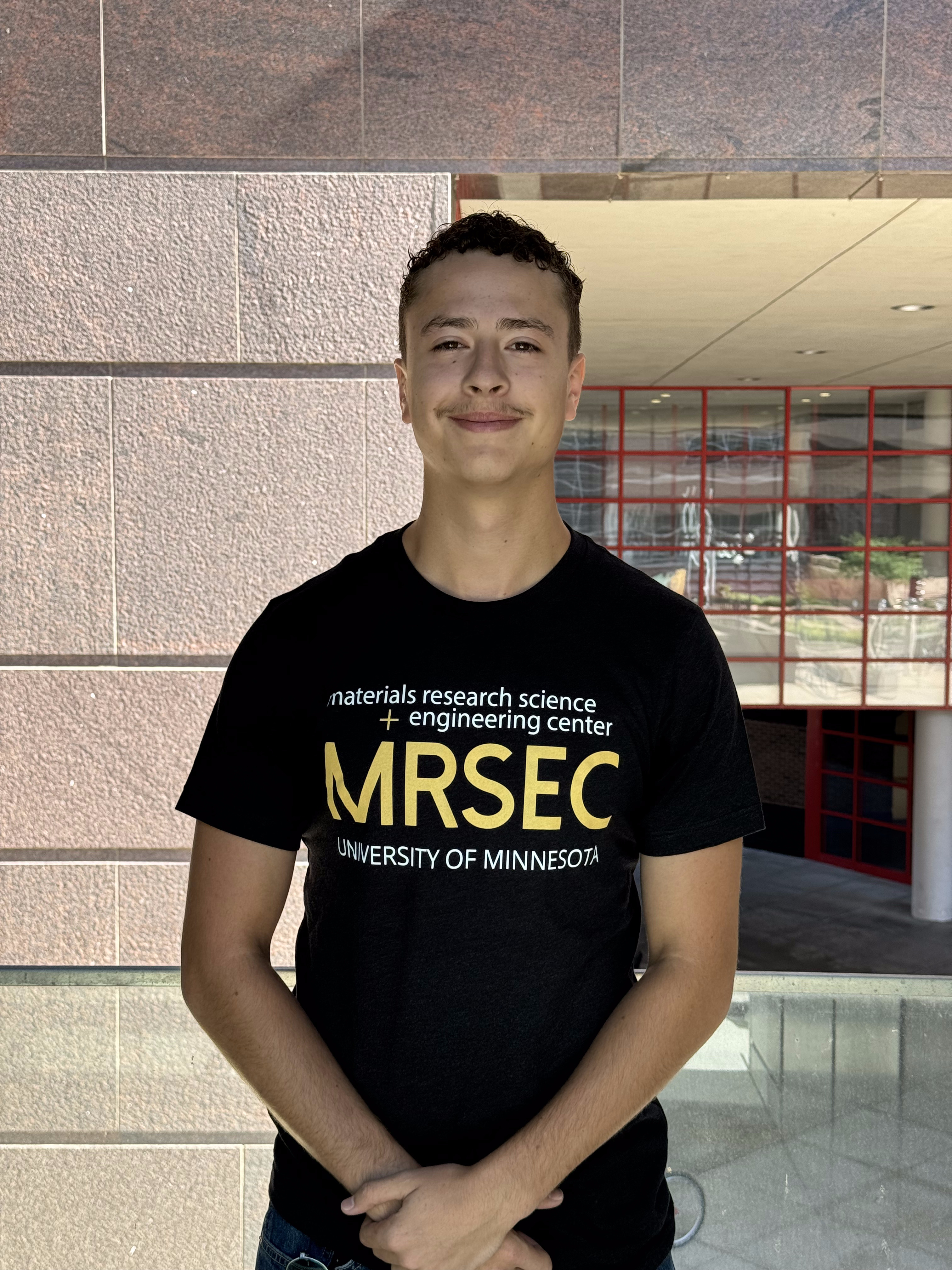
Home Institution: University of Texas Rio Grande Valley
REU Mentor: Bharat Jalan
Effects of Superconductivity by Annealing Ruthenium Based Oxides
Block copolymers have potential applications in areas such as membranes and drug delivery because they can self-assemble into nanostructures, but a current barrier to implementing them is the complex synthesis process, particularly when each block uses a different polymerization mechanism. In this case, synthesis traditionally requires end-group modification of each individual block. One proposed solution is a “one-pot” switchable system with a universal mediator and using external stimuli to control the polymerization sequence: a photocatalyst could perform cationic polymerization when the solution is exposed to light, then anionic polymerization occurs when the solution is heated without needing a separate end-group modification step. This requires a photocatalyst with redox potentials that can perform cationic polymerization and that is neutral so it remains stable in contact with the anionic components of the system. The project involves the synthesis of a neutral photocatalyst (3,6-CF¬3-4CzIPN) hypothesized to possess these target redox potentials. Each step in the synthesis will be analyzed using NMR spectroscopy and variables (time, heat) will be altered to optimize the yield. Upon successful synthesis of 3,6-CF¬3-4CzIPN, its redox potentials will be measured using cyclic voltammetry and fluorescence spectra and its photocatalytic abilities tested in the cationic polymerization of vinyl ethers.
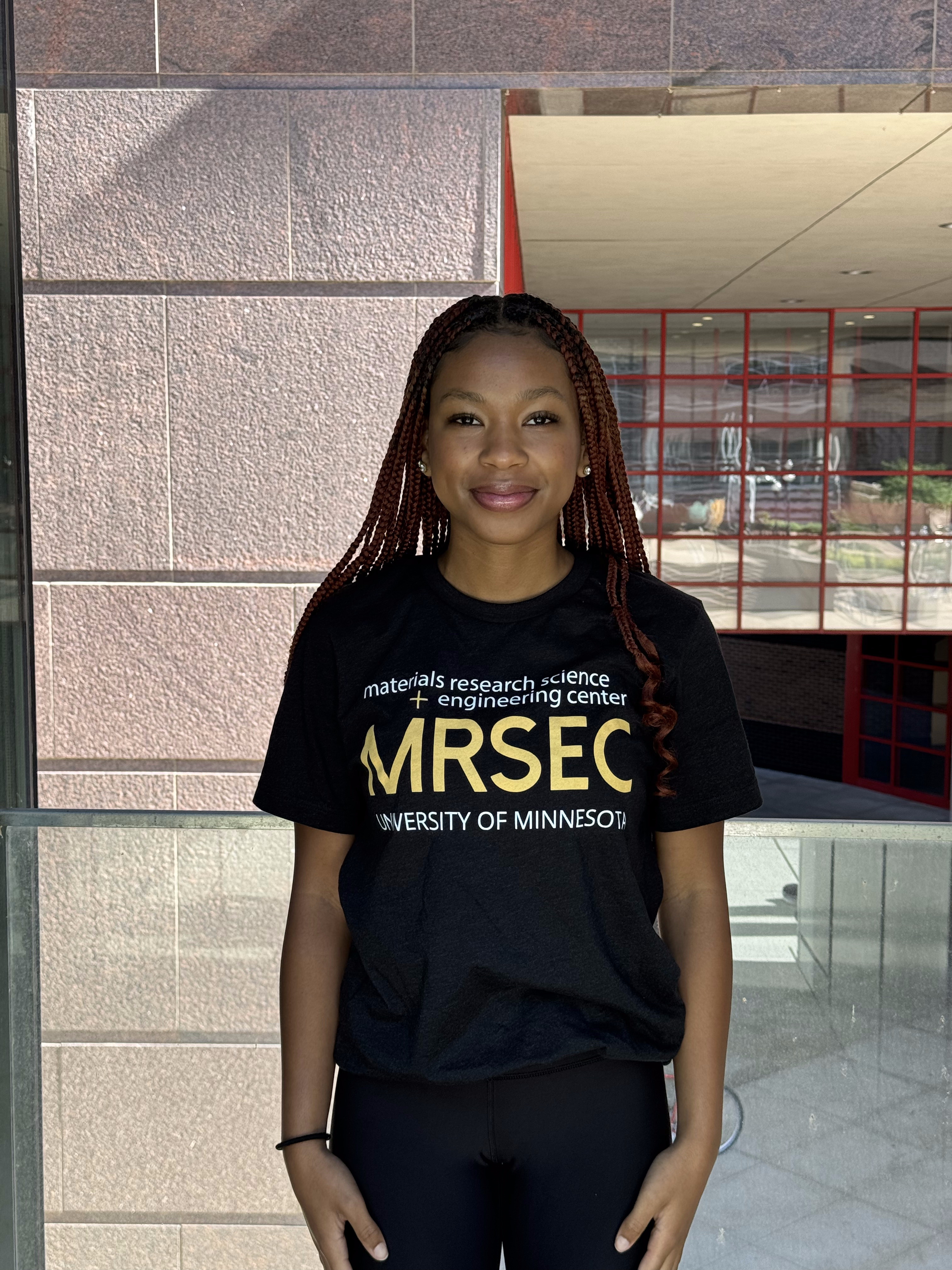
Home Institution: The Pennsylvania State University
REU Mentor: Michelle Calabrese
Role of CPE Tail Length on Rheological Properties of Poloxamer Hydrogels for Drug Delivery
Middle ear infections are exceedingly common in children under five and lack direct and noninvasive
treatment. Aqueous solutions of poloxamers can be used for transtympanic delivery for the treatment of otitis media,
or middle ear infections, due to their thermoreversible micellization behavior. This work utilizes Poloxamer 407 (P407),
which is an ABA triblock polymer that undergoes a solution-to-gel transition with increasing temperature. When P407
is paired with the antibiotic ciprofloxacin HCl and the chemical permeation enhancer (CPE) methyl laurate (ML), a
“pseudo-surfactant” complex forms between the antibiotic and CPE, enhancing the permeation of the tympanic
membrane in the ear. This work evaluates how variations in P407 concentration affect the gel structure, mechanical
properties, and micellization kinetics of P407 hydrogels. Rheology and differential scanning calorimetry were used to
observe the effects of different CPE tail lengths on gelation and mechanical properties of the hydrogels. By tuning
the onset gelation of the formulations, drug delivery can be facilitated near body temperature. These findings will
contribute to a broader study to design a direct and single-dose method of treating otitis media.
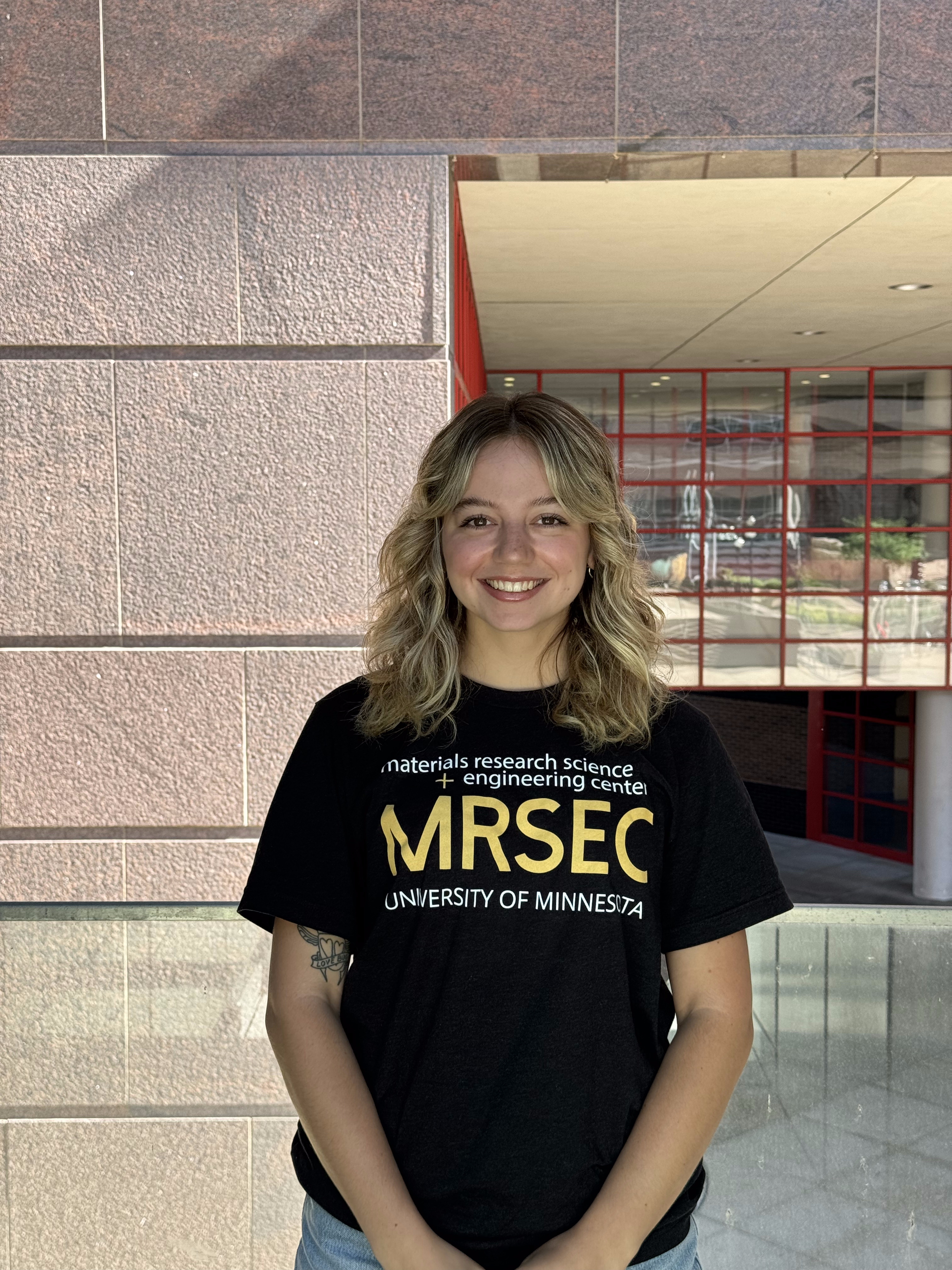
Home Institution: Washington University in St. Louis
REU Mentor: Kade Head-Marsden
Developing quantum algorithms for modeling open quantum systems at temperature with the Bloch-Redfield
equation
Behavior in many quantum systems relevant to present chemistry and materials science is driven by
interaction with an external environment. Quantum algorithms are a useful tool to study the evolution of these open
quantum systems, but presently, the majority of these algorithms can only model behavior at low temperature. The
Bloch-Redfield equation, conversely, offers the ability to examine thermodynamically produced dynamics in open
systems, allowing us to access observables pertaining to temperature. Here, we investigate how the Bloch-Redfield
equation can be implemented to model open quantum systems on current quantum computers. Current hardware
can only implement unitary gates, so we map the non-unitary Bloch-Redfield operations into unitary ones, providing
a mode to model non-unitary behavior at temperature on a quantum computer. As this process can be costly, we
optimize the circuits and operator decompositions by taking advantage of often present characteristics like sparsity
and symmetry.
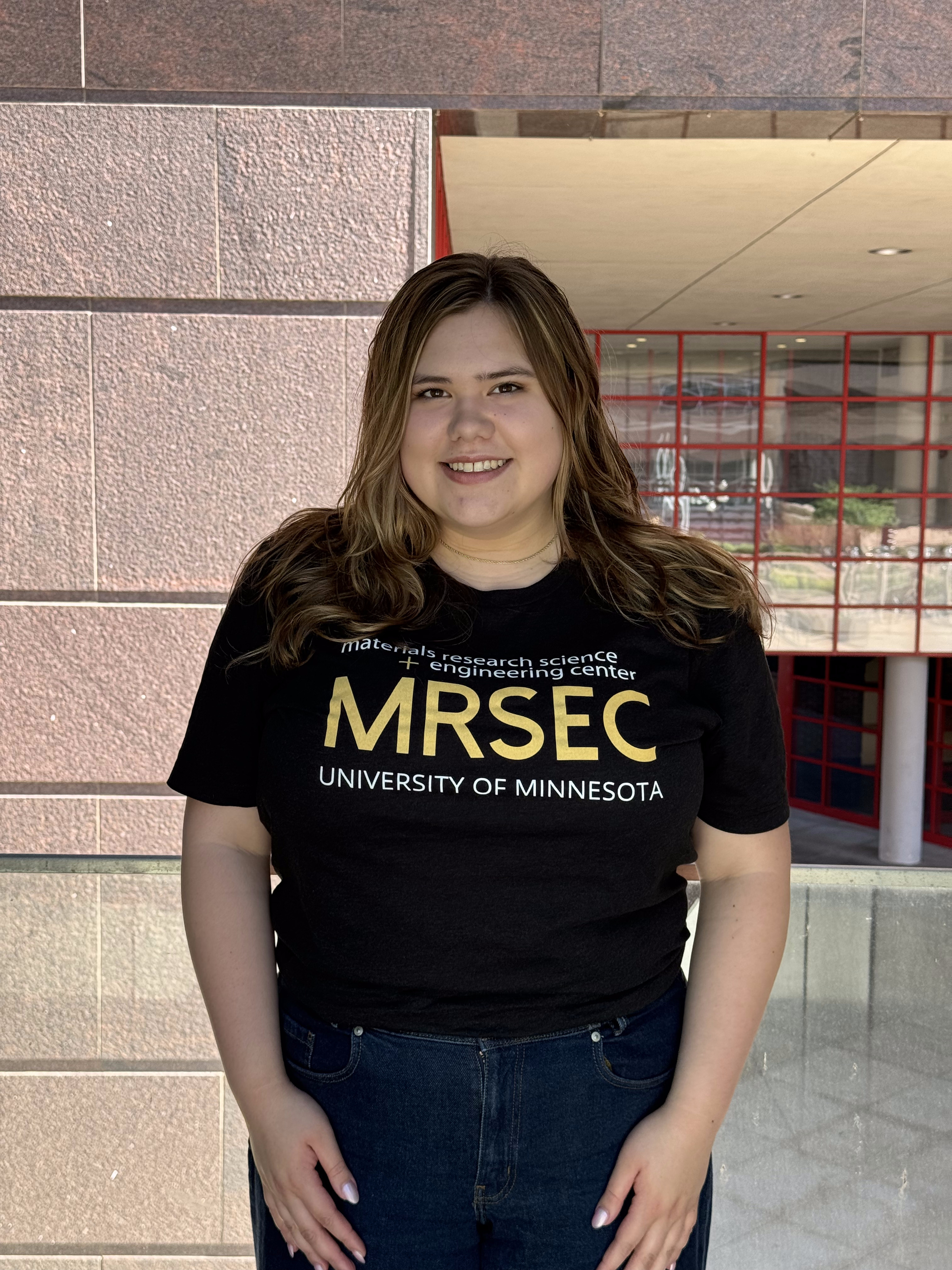
Home Institution: The University of Chicago
REU Mentor: Kelsey Stoerzinger
Electrochemical characterization of ionogels and ionic liquids in varying environmental conditions
Ionogels, consisting of an ionic liquid (IL) encapsulated within a polymer matrix, present a unique
combination of ionic conductivity and mechanical robustness, making them promising candidates for
electrochemical gating, supercapacitors, and solid electrolytes. While the effects of ion identity and humidity on ILs
have been well-documented, the polymer matrix raises critical questions about the polymer's influence on ion
diffusion. This work explores the electrochemical behavior of ionogels compared to neat ionic liquids using cyclic
voltammetry (CV) to determine their electrochemical windows. The neat ionic liquid 1-ethyl-3- methylimidazolium
bis(trifluoromethylsulfonyl) imide ([EMIM] [TFSI]) and EMIM TFSI within a poly(vinylidene fluoride-co-
hexafluoropropylene) (P(VDF-HFP)) copolymer matrix is investigated. Screen-printed electrodes are employed to
examine stability windows on platinum (Pt), gold (Au), and platinum-gold alloy (Pt-Au) electrodes, where varying the
electrode enables understanding of the mechanism of degradation. In situ Fourier Transform Infrared (FTIR)
spectroscopy can probe the distribution of ions at the ionogel-electrode interface. These systems are sparged with
argon (Ar), oxygen (O₂), or air to investigate the role of dissolved water and oxygen. In this project, a deeper
understanding of the processes governing ionogel behavior is determined, influenced by ion identity and
environment, and their implications for advanced electrochemical applications.
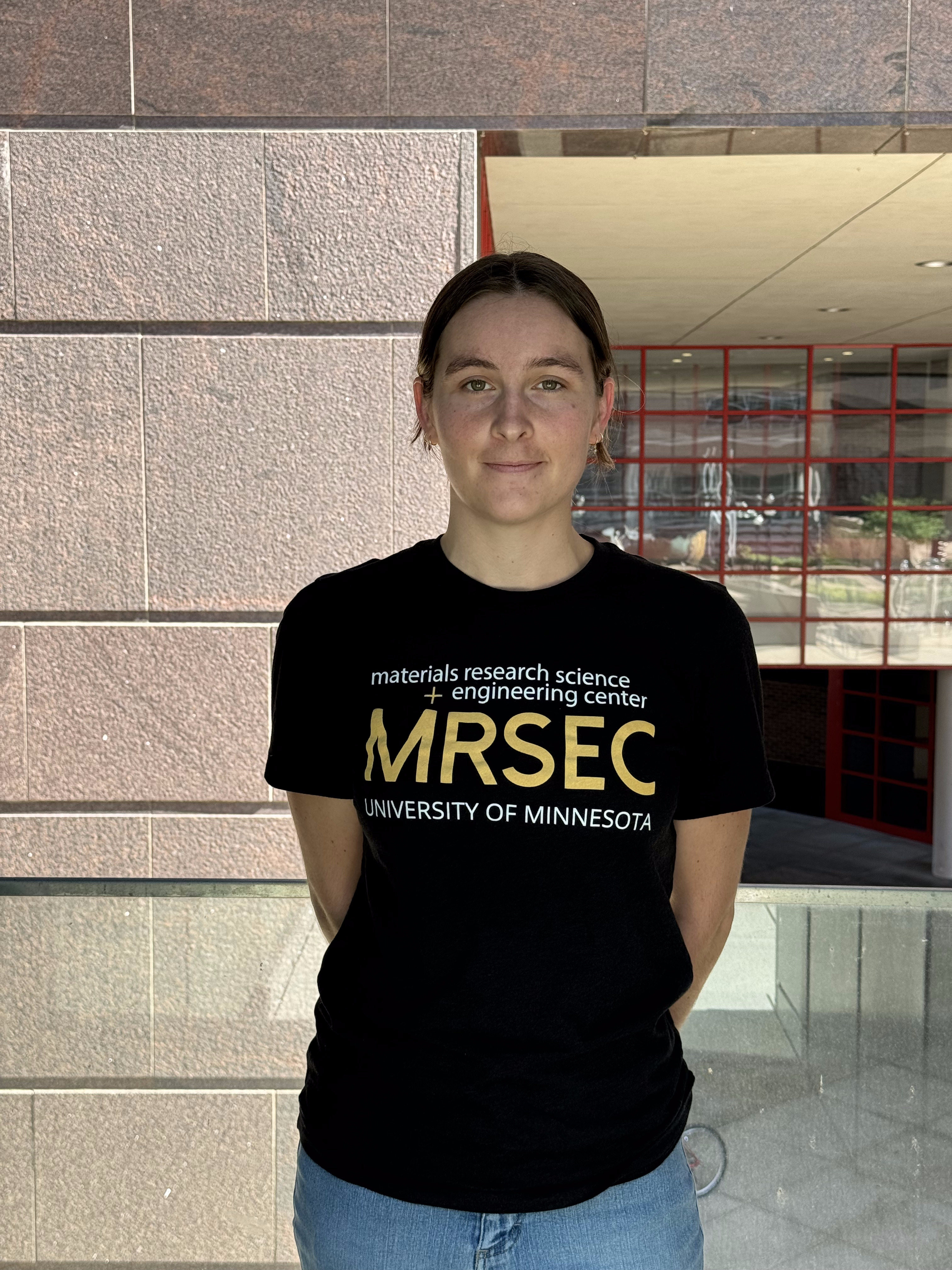
Home Institution: University of Florida
REU Mentor: Michelle Calabrese
Synthesis of Redox Active Polymers via RAFT
Redox-active polymers exhibit tunable electrochemical binding, a property contingent on polymer design,
enabling their utilization in diverse applications such as water purification. Poly(TEMPO methacrylate) (PTMA) is a
redox-active polymer characterized by a nitroxide radical pendant group. When PTMA is combined with electrically
conductive carbon nanotubes (CNTs) and coated onto substrate, a porous network forms. This network has
demonstrated selective and reversible binding to polyfluoroalkyl substances (PFAS) when used in an electrochemical
cell. Higher molecular weight PTMA improves device stability and efficiency but makes the polymer more difficult to
process. Thus, for scalable application, balance must be achieved between good processability and device stability.
Utilizing reversible addition-fragmentation chain transfer (RAFT) polymerization followed by post-polymerization
oxidation, a process of synthesizing PTMA with targeted molecular weight and low dispersity can be established to
determine the optimal point of maximum stability while retaining suitable processability. The precursor polymer
synthesis will be optimized using in-lab equipment to allow for future repeated implementation. Polymer molecular
weight and dispersity was characterized using Size Exclusion Chromatography (SEC) and Nuclear Magnetic
Resonance (NMR). The future of this project includes evaluating processability through solubility screenings and
dripping onto substrate (DoS) to establish the optimal balance between processability and device stability.
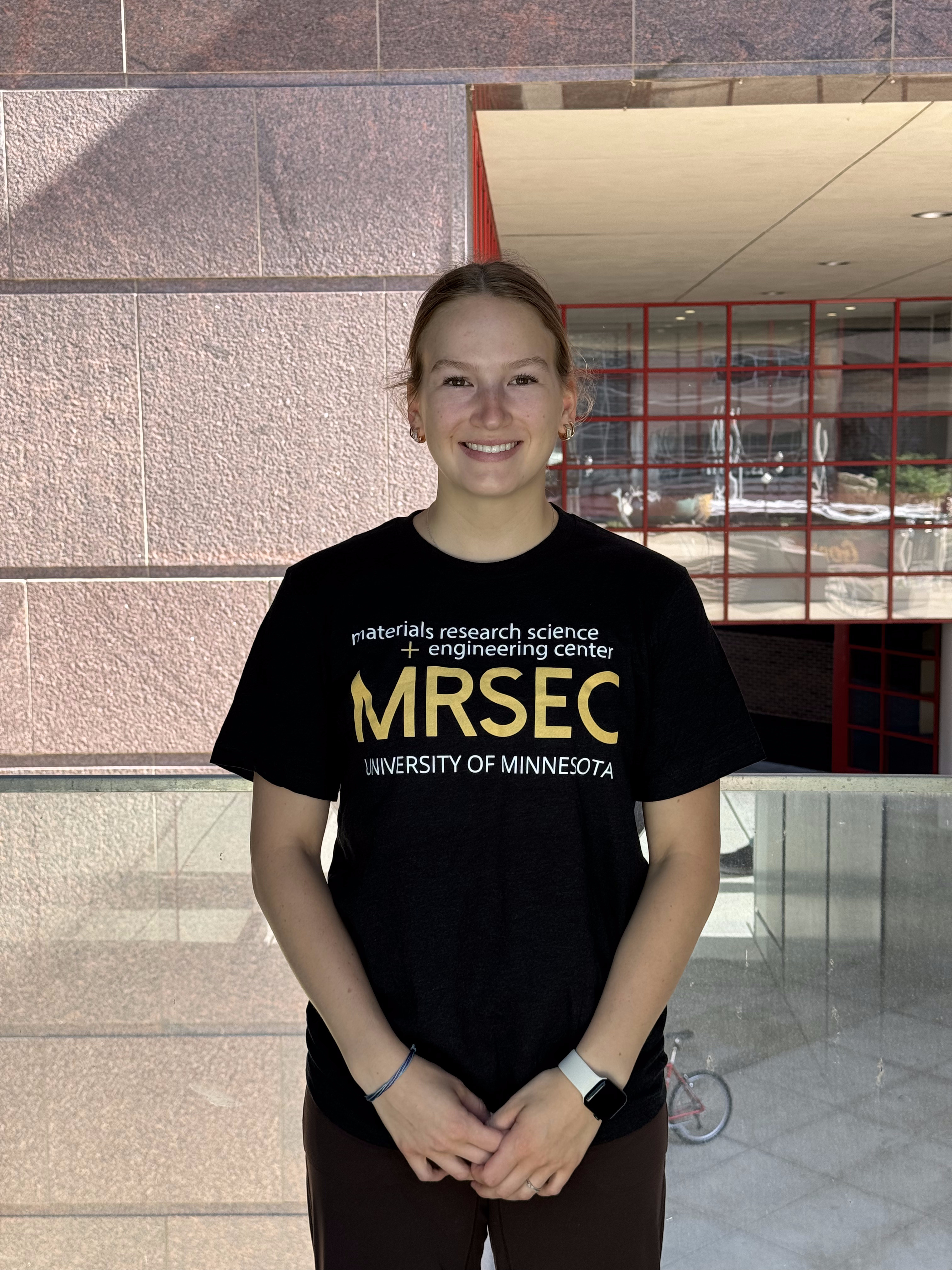
Home Institution: St. Olaf College
REU Mentor: Vivian Ferry
Fabrication of Large-Area Stamps Using Stamp and Step Technique for Roll-to-roll Nanoimprint Lithography
Nanoimprint lithography (NIL) is an efficient method for creating large-area nanopatterns, known for its high
throughput, high resolution and low cost. Its commercial applications are growing in fields like photonics, surface
engineering, and metamaterials. The NIL process starts with fabricating a master mold using techniques like optical or
electron-beam lithography, which is used to produce imprinting stamps that create nanopatterned surfaces. Scaling
NIL to a roll-to-roll (R2R) process is challenging because current master pattern fabrication methods are limited to
small areas. Typically, large-area stamps for R2R NIL are made by stitching together small-area stamps, leading to
rough surfaces at the seams. To address this, we implemented a method called stamp and step, which involves
making multiple imprints with minimal gaps using a small-area stamp on a substrate. The edge roughness of these
small imprints was optimized by adjusting the imprinting pressure. Additionally, we developed self-standing imprints.
These imprints were applied to a substrate that already contains multiple imprints, reducing gaps and ensuring
seamless coverage. By applying these techniques, we successfully produced a large-area master mold and a
corresponding large-area stamp for R2R imprinting. Experimental results highlight the promise of this method for
advancing various large-area NIL-based devices and materials.
School: Friends Academy, Long Island, NY
Mentor: Boya Xiong
Title: Developing a Researcher: Designing Curriculum to Explicitly Teach Skills Necessary for Success in a Research Setting
As STEM educators we have a two-fold responsibility of both teaching the content of our field and also of
preparing our students to become successful researchers. Too often, the pressure of finishing our curriculum under the
time crunch of the semester forces us to choose between content and skills. Most often, we choose content at the
cost of skills. The work of this MRSEC RET Project aims to identify the universal skills necessary to build impactful and
confident researchers. This project as makes some suggestions of curricula and instructional strategies for explicitly
and intentionally teaching research skills.
School: White Bear Lake High School
Mentor: Phil Engen
Title: Innovative Approaches to Chemistry Instruction for High School Classrooms: A Workshop for Summer 2025
As STEM educators we strive to meet the standards as they change and to tackle the challenge of staying
current and relatable to youth in our classrooms while we illustrate the global impact and importance of scientific
research at our students' levels. To address these challenges, the proposed 3-day workshop will focus on innovative
approaches to chemistry instruction for high school classrooms and include topics such as sustainability, green
chemistry and climate action. Through the MRSEC RET program, Beyond Benign, and other programs, teachers and
university researchers have collaborated to develop a collection of activities grounded in modern research yet
suitable for the high school classroom. The workshop is designed for high school chemistry teachers who are
passionate about transforming their teaching practices and inspiring students in chemistry. Workshop participants will
leave with practical strategies and activities for implementing innovative chemistry instruction. They will also leave
with access to a curated collection of resources and tools for enhancing chemistry lessons and a network of like-
minded educators for ongoing collaboration and support. Our goal is to provide inspiration and confidence to
educators to create engaging, meaningful, and student-centered chemistry experiences in their classrooms.
School: Eden Praire High School
Mentor: Boya Xiong
Title: Seeing is believing. The development of curriculum regarding the production of microplastics from weathering through various means has lacked experimental opportunities in the general high school classroom. This project focuses on introducing students to weathering processes of various plastic types, and the subsequent identification of small particle production through fluorescent labeling and microscopic examination. The ability to see very small fragments of plastic will hopefully engage students to become more environmentally conscious.
UMN MRSEC
435 Amundson Hall, 421 Washington Ave. SE, Minneapolis, MN, 55455
P: 612-626-0713 | F: 612-626-7805
UMN MRSEC
137D Amundson Hall, 421 Washington Ave. SE, Minneapolis, MN, 55455
P: 612-626-0713 | F: 612-626-7805